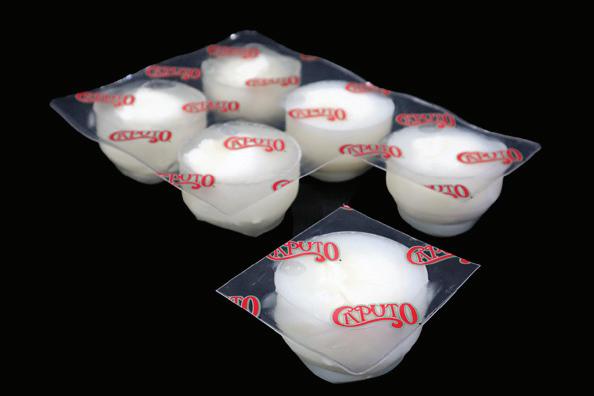







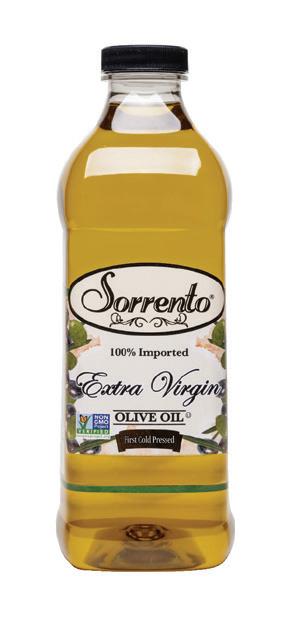


It’s easy to be the ‘advocate of the independent pizzeria.’
You already do the hard part.



































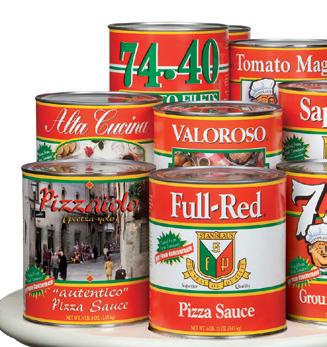





Lynn Humphreys and Brandon Bruner think of Lynn’s Chicago Pizza, located on the city’s South Side, as a “traditional pizzeria,” but their marketing strategy is thoroughly modern—and splendidly executed. Earned media coverage for their deep-dish pizzeria is a crucial facet, and features in the Chicago Tribune, the Chicago Reader and Block Club Chicago illustrate the couple’s ability to tell their story in compelling fashion. They’ve also forged relationships with influencers, particularly in the Black community, to create buzz, and drive traffic with promotions like open mic nights, game nights and karaoke. They have to pull out all the stops to get locals to spend their hard-earned dollars. “Our community is not accustomed to a lot of dine-in restaurants,” Humphreys says. “We’re in a community that’s predominantly Black and underinvested in. So now we’re trying to use those activities and promotions to bring in more dine-in [business].” How did Lynn’s Chicago Pizza get on PMQ’s radar? It started with a polished, thoughtfully composed email to every editorial team member. “Our journey from a love-filled home kitchen experiment to becoming a community-focused restaurant is a story of passion, resilience and entrepreneurship,” Humphreys wrote. That’s our kind of pitch!
Scan this code to subscribe or renew your subscription to PMQ! Or visit PMQ.com/subscribe
CONTENT
EDITOR IN CHIEF Rick Hynum rhynum@wtwhmedia.com
SENIOR EDITOR Charlie Pogacar cpogacar@wtwhmedia.com
ASSOCIATE EDITOR Tracy Morin tmorin@wtwhmedia.com
ASSOCIATE EDITOR/USPT COORDINATOR Brian Hernandez bhernandez@wtwhmedia.com
VP, ASSOCIATION AND COMMUNITY ENGAGEMENT Allison Dean adean@wtwhmedia.com
VP, EDITORIAL DIRECTOR Danny Klein dklein@wtwhmedia.com
ART & PRODUCTION
ART DIRECTOR Eric Summers esummers@wtwhmedia.com
SENIOR ART DIRECTOR Tory Bartelt tbartelt@wtwhmedia.com
DIGITAL PRODUCTION COORDINATOR Blake Harris bharris@wtwhmedia.com
A Publication of WTWH Media, LLC 662-234-5481
Volume 29, Issue 2 March 2025 ISSN 1937-5263
CONTENT STUDIO
VICE PRESIDENT Peggy Carouthers pcarouthers@wtwhmedia.com
WRITER
Ya’el McCloud ymccloud@wtwhmedia.com
WRITER
Abby Winterburn awinterburn@wtwhmedia.com
SALES & BUSINESS DEVELOPMENT
VP, SALES Lindsay Buck lbuck@wtwhmedia.com
NATIONAL SALES MANAGER Tom Boyles tboyles@wtwhmedia.com
NATIONAL SALES MANAGER Mike Weinreich mweinreich@wtwhmedia.com
VP, BUSINESS DEVELOPMENT Eugene Drezner edrezner@wtwhmedia.com
CUSTOMER SERVICE REPRESENTATIVE
Brandy Pinion bpinion@wtwhmedia.com
FOUNDER
Steve Green

PMQ PIZZA Issue 2 March 2025 (ISSN 1937-5263) is published monthly in January, March, April, May, June, August, September, October, November and December by WTWH Media, LLC, 1111 Superior Ave #2600, Cleveland, OH 44114-2560.
Periodical postage pricing paid at Cleveland, OH. Additional mailing offices at Bolingbrook, IL.
POSTMASTER: Send address changes to PMQ PIZZA, 1111 Superior Ave #2600, Cleveland, OH 44114-2560.
Cost of U.S. subscription is $25 per year. International $35.
Opinions expressed by the editors and contributing writers are strictly their own and not necessarily those of the advertisers. All rights reserved. No portion of PMQ PIZZA may be reproduced in whole or part without written consent.

30 The Pivot: Pop-Up to Brick-and-Mortar
Brick-and-mortar stores are no longer the sole entry point into the pizza business as a new generation stakes its claim via pop-up operations.
38 The PMQ Pizza DELCO Report

What do customers really think about the leading chains’ delivery and carryout services? PMQ’s collab with Intouch Insight provides eye-opening clues.
48 Achieving the Perfect Crust
A trio of experienced pizza professionals share their wisdom on the tricky nuances of dough management and crust development.
56 The Final Verdict
As both a contestant and a judge, U.S. Pizza Team member Dave Sommers of Mad Mushroom offers his insights on pizza making competitions.


Women in Pizza founder Alexandra Mortati handpicks the movers and shakers—like Jackie Mazza of DHS Hospitality—who are making our pizza community better for everyone.
By ALEXANDRA MORTATI

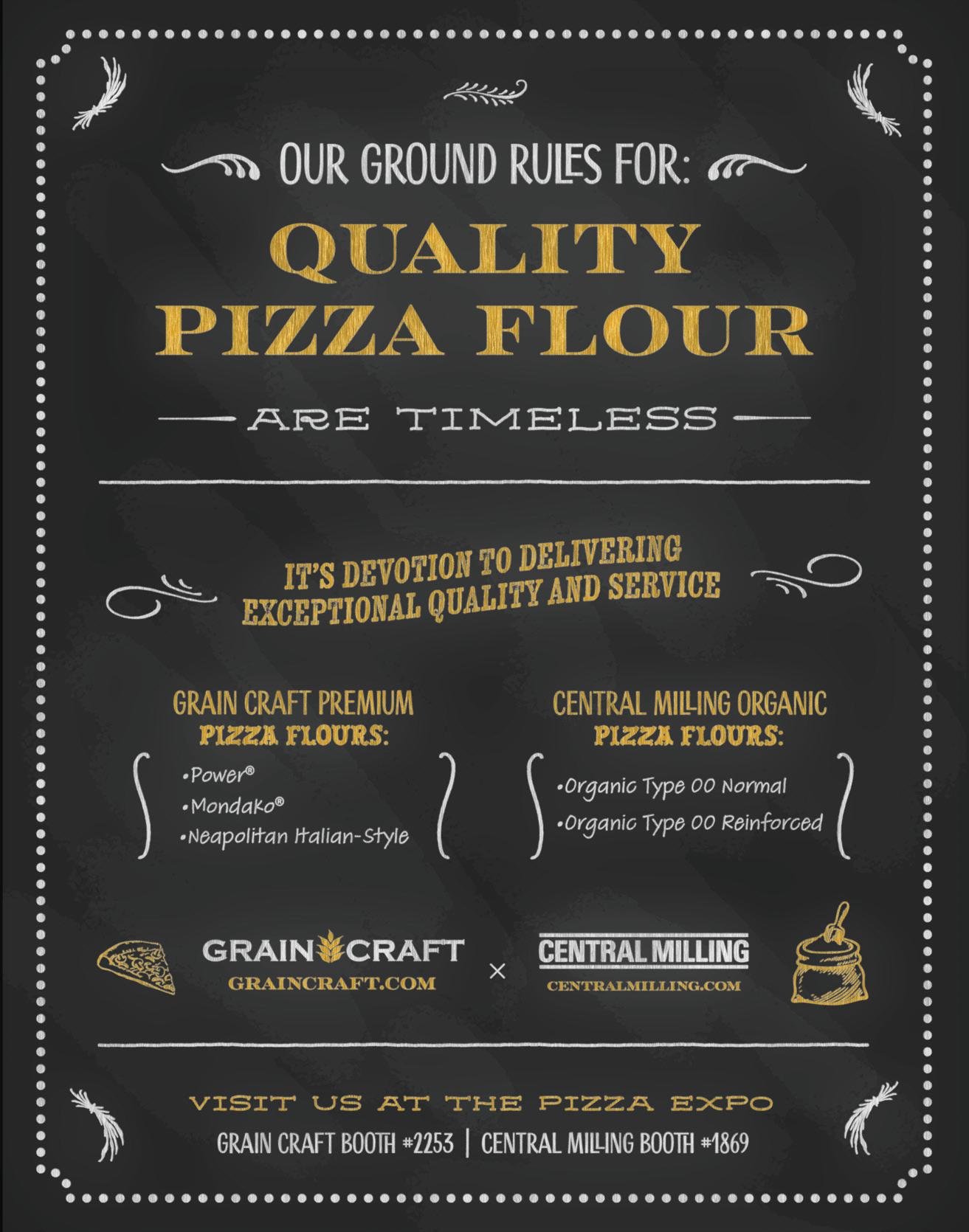


IN A MARKETING STRATEGY WE CAN ONLY DESCRIBE AS paw-sitively brilliant, one of the two Bartoli’s Pizzeria locations in Chicago has found viral success with a walk-up window catering to man’s best friend—not for pizza to go, but for doggie treats. Thanks to a TikTok page (@pizzadoggietreats) showcasing the counter service for canines, Bartoli’s has racked up free publicity with videos featuring “regulars” like Juice, who showed up in mid-December looking dapper in a red sweater and earmuffs to sniff out a treat. The TikTok videos often garner tens of thousands of views, sometimes hundreds
of thousands. When beautiful Butters dropped by in late January and expressed disdain for a large cookie—just the plain doggie biscuits for Butters, thank you—that video topped 738,000 views and 134,000 likes. Bartoli’s owner Brian Tondryk credits his manager, Stacy Rozack, for developing the walk-up window. “Oh, my God, there’s hundreds [of dogs] that…walk by every day,” Tondryk told USA Today. “When the owners are walking the dogs, they always want to stop at the pizzeria because [their pups] get a treat.”
A trio of local influencers partnered with Andolini’s Pizzeria in January to celebrate the chain’s 20th anniversary, reflecting owner Mike Bausch’s marketing savvy and the brand’s status as a beloved institution in Tulsa, Oklahoma. For Andolini’s Battle of the Pizzas, each influencer created a specialty pie and took to social media to promote it, largely through high-energy videos on TikTok and Instagram. They also appeared together on a local TV news segment that helped Andolini’s reach a more traditional audience. Introducing The 918 Agent was Tulsa realtor Stephen Hester, with a combined 108,400 followers on TikTok and Instagram, who touted a pie with a white base, pancetta, fried onions and honey. Tarra Quinn, who boasts a total of 53,000 followers on those same platforms, pushed the High It’s Tarra pie, topped with pickles, pancetta and a drizzle of garlic olive oil. An influencer known as @tulsabite (real name undisclosed), with a combined following of nearly 49,000, piled the Tulsa Bite pizza with cup-and-char pepperoni, pickled jalapeños, peppadew peppers and a dipping cup of ranch drizzle with hot honey. Plans called for the best-selling pizza to be added to Andolini’s menu “indefinitely,” with proceeds going to support Tulsa City Lights, a local nonprofit. As of press time, the winner had not been chosen, but the Tulsa Bite pie was in the lead.

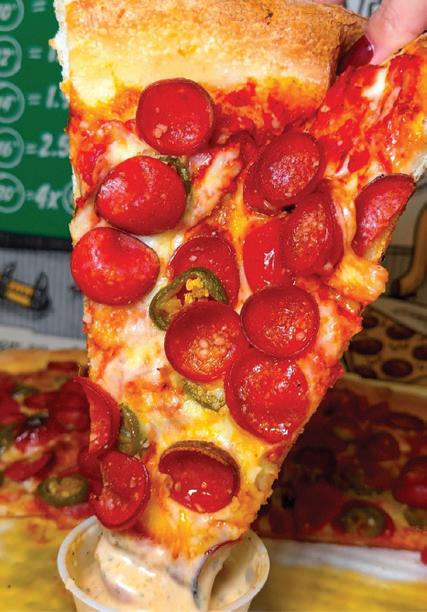
In an industry that relies heavily on young employees, pizza chains and independents alike are recognizing the importance of keeping team members on the job while helping further their career goals. Iowa-based Happy Joe’s Pizza & Ice Cream aims to do exactly that with the new Hollie Matthys’ Scholarship Award. Named in honor of Happy Joe’s former CFO, who served the brand for more than 21 years, the scholarship is designed to support salaried or hourly employees who meet the criteria outlined in the employee handbook. Recipients get $500 per semester for tuition and expense support. The first recipient, announced in December 2024, is Makynzee Balluff of Davenport, Iowa. Matthys’ own journey with Happy Joe’s began early in her career when she was assigned to audit the company while working for a public accounting firm. Her admiration for the brand’s values and leadership, particularly its founder, “Happy” Joe Whitty, led her to join the company in 2003. “Her impact on our company was immeasurable,” Happy Joe’s CEO Tom Sacco says, “and this scholarship is a testament to her unwavering support for others.”
In Italian, Amici means friends — and friends of Margherita and our authentic Italian meats get exclusive access to new products and members only promotions. Heat up your menu and earn rewards by joining the Margherita Amici Loyalty Program!
AS AN AMICI MEMBER, YOU’LL ENJOY:


Exclusive first access to on-trend ingredients.



Rewards & points with every purchase of Margherita products.
Special promotions tailored just for you.
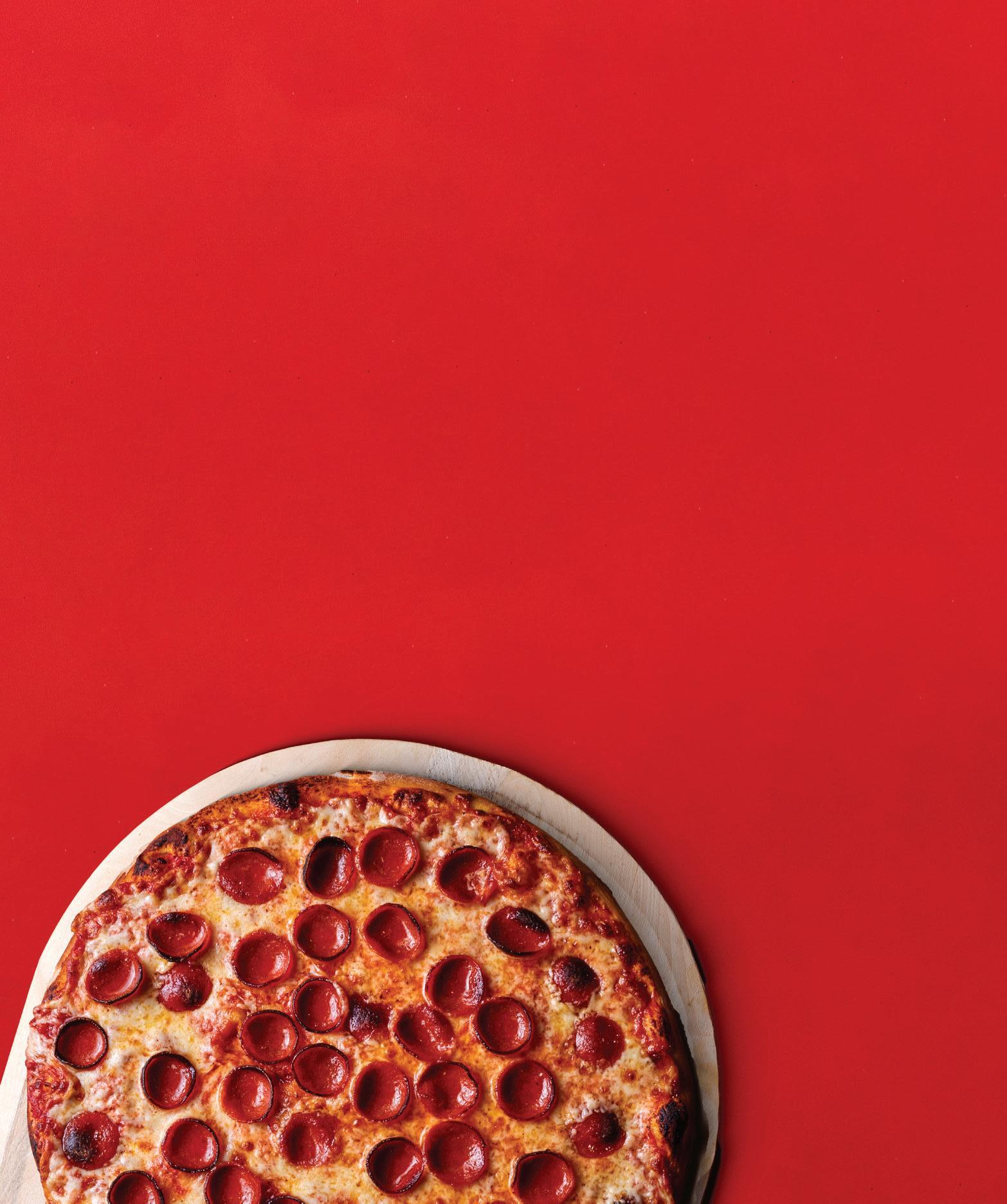
Stop by Booth #2501 at Pizza Expo for a special new product launch!

Datassential projects this ingredient’s menu growth to surpass 100 percent of foods in four years.
Consumer interest in spicy foods has been on the rise, with 70 percent of individuals now expressing a love for spicy flavors—a significant increase from previous years, according to the Supply Side Food & Beverage Journal. This growing appetite for heat is evident across various demographics, including younger generations who are increasingly seeking out bold and adventurous taste experiences. The trend has also given rise to innovative flavor combinations, such as the “swicy” blend of sweet and spicy, which has gained popularity in both the food and beverage sectors. As consumers continue to explore and embrace spicier options, the demand for products like
hot honey is expected to remain strong, solidifying its position as a versatile and enduring condiment in the culinary world.
“Datassential predicts hot honey’s menu growth to outperform 100 percent of all foods over the next four years,” says Mike Kurtz, founder of Mike’s Hot Honey. “We’ve been named the flavor of the year and what’s hot by the industry press year after year; the growth of hot honey on menus backs it up. This trend is not slowing down.” Hot honey, a trend with staying power, has fueled the rise of “swicy” flavors, enhancing pizza, wings, sandwiches, and salads. Mike began drizzling his signature hot honey on pizzas at a

Brooklyn pizzeria, where customers soon asked to buy bottles to take home.
“Much of the growth continues to be through word-of-mouth from fans and tastemakers,” Kurtz says. “Someone new to discovering Mike’s Hot Honey may have the impression that it’s a new, trendy condiment that just appeared in response to the popularity of hot honey/swicy flavors, but actually the opposite is true. Mike’s Hot Honey started the hot honey trend, which is the driving force behind the growing interest in swicy flavors.”
The flavor packed and viral ingredient is not the only thing that sets Mike’s Hot Honey apart from other suppliers. Mike’s Hot Honey strives constantly to listen and understand operators’ struggles and adapt its product to meet operator’s needs. “We are constantly listening to feedback from operators and partners to make sure that Mike’s Hot Honey is ahead of the curve when it comes to challenges operators are facing every day,” Kurtz says. “We know the success of our product in foodservice is dependent on the success of the operators using it, so when we see an opportunity to improve, we do our best to implement it.”
It is no secret that the restaurant world post-pandemic is strained, operators across all sectors are looking to find ways to cut costs and increase revenue in 2025. TouchBistro’s 2025 State of Restaurants Report revealed the top ways operators are looking to cut costs and drive revenue. Thirty-eight percent of operators are looking to reduce food waste, and on the flip side, 34 percent are hoping to invest more in marketing efforts to increase revenue. These tactics can often fall short if an operator doesn’t have one eye on the trends swaying consumers, even harder is knowing which trends will have the staying power to be worth investing in.
Mike’s Hot Honey was aware of these issues and in response rolled out the Drizzle-Ready Cap based on requests from leading chains to decrease food waste, increase efficiency, and
ease of use. The Drizzle-Ready Cap is made with the widely used and popular FIFO Innovations™ bottom-dispensing cap.
Mike’s Hot Honey is proudly the first brand to introduce FIFO Innovations™ dispensing cap technology on their standard foodservice packaging. This design allows for a 25 percent reduction in waste and is 2–3 times faster.
Simply decreasing waste is no longer enough to compete in 2025, which is why marketing efforts are so vital to success. “Mike’s Hot Honey offers marketing support through menu branding and promotion collaboration, as well as resources like signage and displays to help restaurants drive sales,” Kurtz says. “Customers are excited to try Mike’s Hot Honey menu items due to our large buzz on social media and the growing trend of hot honey.”
Moving into 2025 Mike’s Hot Honey is expected to grow into less traditional dayparts like breakfast and dessert.
“Mike’s Hot Honey is best known as a pizza topping, having been founded in a Brooklyn pizzeria in 2010,” Kurtz says. “Pizza and chicken, like fried chicken and wings, have traditionally been the two top pairings. In 2025, we expect to see more applications in beverages like coffee drinks and cocktails as well as desserts and sandwiches.”
As consumer interest in bold flavors continues to rise, hot honey has solidified its place as more than just a passing trend—it’s a staple that operators can leverage for both flavor innovation and business growth. With the “swicy” movement gaining momentum and operators looking for smart ways to increase efficiency and drive revenue, products like Mike’s Hot Honey are proving their long-term value. By listening to operators’ needs and introducing solutions like the Drizzle-Ready Cap, the brand is setting a new standard for how condiments can enhance both the customer experience and back-of-house operations. As 2025 begins, restaurants that embrace enduring trends and invest in smart marketing strategies will be best positioned for success.

“Thousands of restaurants around the country are using Mike’s Hot Honey through incredible collaborations with iconic brands like Dunkin’ Donuts, California Pizza Kitchen, and First Watch,” Kurtz says. “Our new innovative Drizzle-Ready Cap is a game-changer for the food service industry, making it easier and more efficient than ever to drizzle our hot honey on everything from pizza and wings to breakfast sandwiches and desserts.”
For more information on partnering with Mike’s Hot Honey visit mikeshothoney.com/ pages/foodservice.

Meet the changemakers, power players and pie-slinging prodigies who are making our pizza community better for everyone.
ABY ALEXANDRA MORTATI GUEST EDITOR AND FOUNDER, WOMEN IN PIZZA
COURTESY OF FEATURED SUBJECTS
S A NEW GENERATION OF WOMEN ASCEND TO LEADERSHIP POSITIONS, the pizza community worldwide is feeling the effects—all positive, we believe. For our second annual 10 Women to Watch feature, PMQ once again turned to Alexandra Mortati, founder of the nonprofit Women in Pizza, to handpick the movers and shakers who are challenging the male-dominated status quo and powering the industry onward and upward to a more equitable—and prosperous—future. Check out Women in Pizza at WomeninPizza.com and follow the organization at @womeninpizza on Instagram for regular live interviews and more uplifting, informative articles!

As a five-year-old who already dreamed of being a chef, Jackie Mazza nearly burned the house down a time or two. She’d borrow cookbooks from her kindergarten library and sneak downstairs every Sunday morning to make breakfast. “There were a few close calls where the toaster oven caught fire,” she remembers. “Oh, and the microwave went up in flames once. There was no way my parents were letting a five-year-old make breakfast, so I have these vivid memories of my father flying out of bed.”
But Mazza proved unstoppable. After earning a degree in culinary arts and restaurant management, she worked as a pastry chef, opened her own bakery and eventually co-founded a neo-Neapolitan pizza bar called Fatto Americano. The pandemic shut it down, leading to her current role at DHS Hospitality, where she oversees seven different restaurants.
Along the way, this culinary wizard has competed on Beat Bobby Flay and Cutthroat Kitchen. Her latest project: DeeDee’s Pizza in Highland Park, New Jersey, where she trained the team on the intricacies of New York rounds
“I hate the expression, ‘If you do what you’re passionate about, you never work a day in your life.’ If you do what you’re passionate about, you work constantly!”
Jackie Mazza, DHS Hospitality
and Sicilian squares. She works so hard, she says, “I need to grow a third leg.” But, she adds, “I feel like you don’t choose this industry—this industry chooses you. I hate the expression, ‘If you do what you’re passionate about, you never work a day in your life.’ If you do what you’re passionate about, you work constantly!”
Read more at PMQ.com/jackie-mazza.
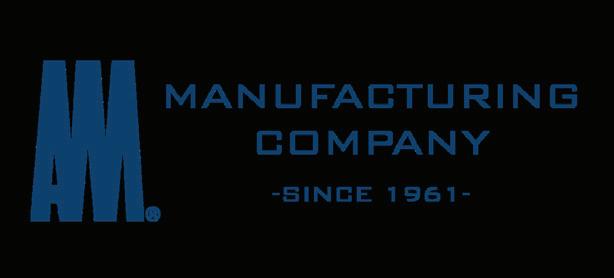

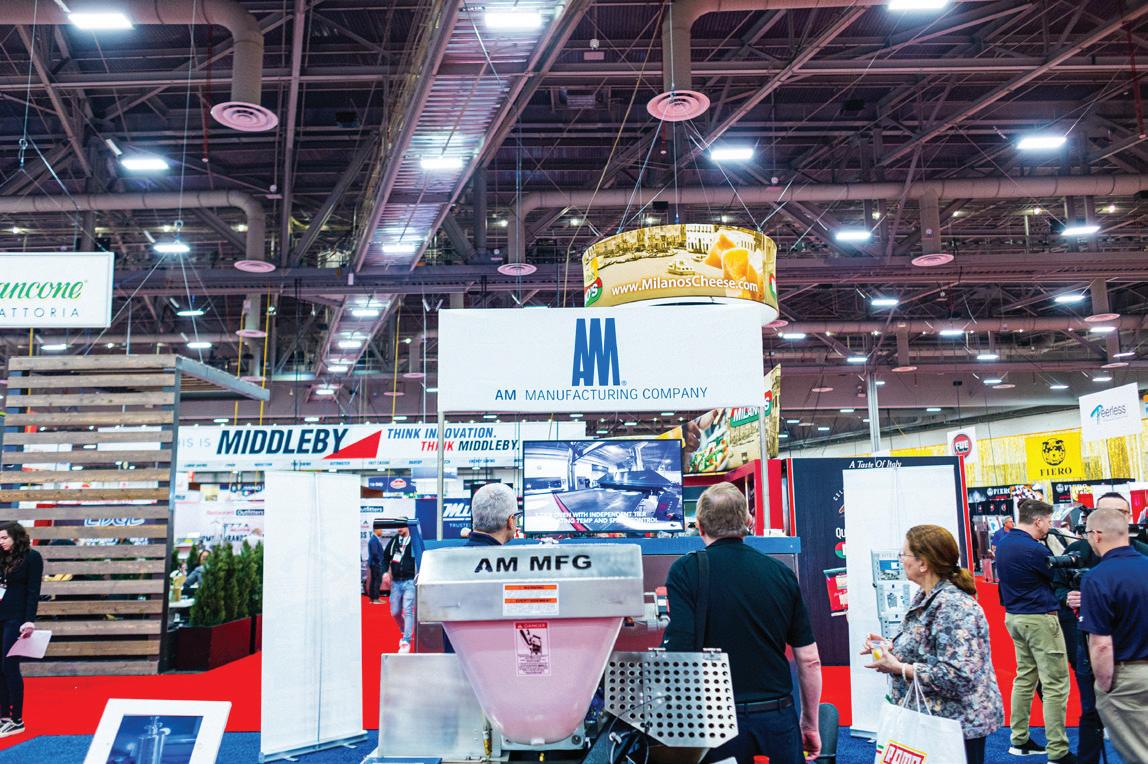





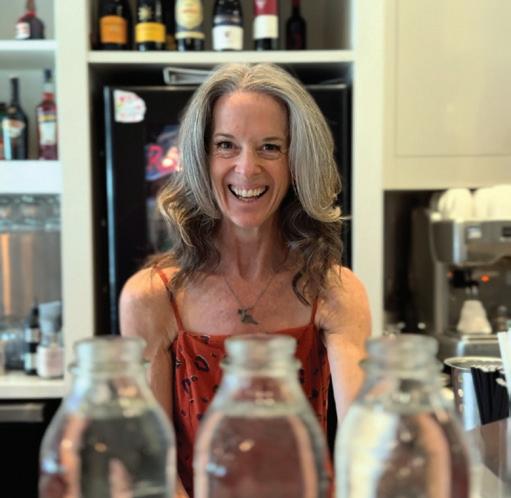
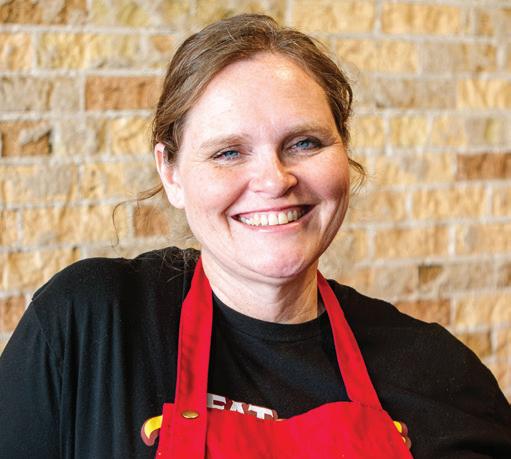
Before she purchased a Famoso Pizzeria + Bar franchise, Andrea MacLeod usually said no to opportunities that took her out of her comfort zone. But she finally grew tired of coasting. “I was at a fork in the road and needed to make a choice about whether I wanted to give 60 to 70 hours a week as an employee or as a business owner,” she recalls. “So I said, ‘F--- it. If a bank will give me a small business loan, I’ll do it, and if they won’t, I won’t.’”
A Red Seal Certified Chef with more than 30 years of commercial kitchen experience, MacLeod got the loan and has been confronting the challenges of restaurant ownership ever since. And she had a lot to learn— handling broken ovens and compressors, unplugging toilets and “protecting my servers from creeps.” Her husband, who is disabled due to a massive stroke, formerly took care of the family’s finances. Now, she says, “I’m learning how to be a master financial manager.”
She’s also learning to thrive in a business once dominated by men. “To be in this industry, you really need to be ruthless,” she says. “Men like being like that. It’s good for their self-esteem and makes them thrive and work harder. It ends up being good for their business and financial success. But, for women, not so much. I’m not a person who gets mad that often. I’d rather just talk about the solution than get triggered and angry.” The key, she says, is to “make sure emotions are not involved when making decisions….It’s not emotional in business. If you think owning a restaurant will be fun, you’ll go down with 95% of the rest of them.”
Read more at PMQ.com/andrea-macleod.
When Janine Coons opened Fat Daddy’s, she already co-owned another Italian restaurant with a friend. Before long, she was running herself ragged, especially after that friend had to step away. “I spent 2023 trying to figure out who I was and what I was doing,” she recalls. “I had a handle on the back end, but marketing was a mystery. My friend was the face of the business, and suddenly, that role was empty. I knew I needed help to tell our story, so I hired someone.”
That someone was Sia Sepehrnia, whose previous “toxic” job had left her feeling undervalued and trapped. “I walked into the pizzeria and was immediately drawn to its retro vibe,” Sepehrnia says. “Janine started talking about her goals, and I knew I could help her express her story.” Together, they’ve become master storytellers, with Coons—a self-described nurturer and caretaker—as the central character. They have created content that showcases Janine’s journey, including blogs like “A Day in the Life of a Pizzeria Owner.”
Meanwhile, Coons empowers her employees as well as her children, who work at the pizzeria. “I want my kids to see that they can do hard things and face challenges head-on,” she says. Sepehrnia, too, values helping others and hopes to continue running fun events, like a Star Wars-themed “May the 4th” promo that proved a huge success. “Food marketing is something I didn’t know I needed,” she says, “and I’m always happy to offer advice to others.”
Read more at PMQ.com/janine-coons.
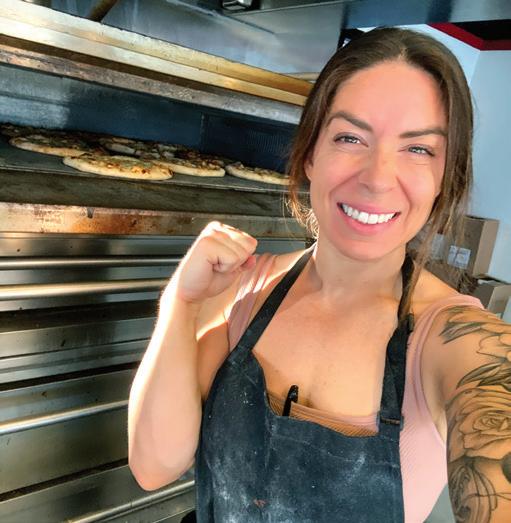

Christina Martin could teach a master class on team building and management. As the owner of Manizza’s Pizza, she oversees a passel of youngsters—an unenviable task for many operators, but one that Martin handles with skill, wisdom and aplomb. An employee who wants to move up in Martin’s business had better be ready to read a book or two (or four). And Martin keeps a library in the lobby just for them. “Some are about personal development, and others are business biographies,” she says. “To be promoted, you have to finish two books and write book reports. My mentor is Mike Bausch [owner of Andolini’s Pizza in Tulsa, Oklahoma], and I want to encourage them to read his book, so that one is a two-for-one special. You can read Unsliced instead of having to read two books.”
Martin maintains checklists for onboarding new employees and knows who learned what from whom. “If they screw up the sauce, I know who taught them how to make it and when. If they are really good on the register but struggling with a calzone, we can identify it and help them prioritize. I’m big on checklists, but they must be worthwhile and important. Everyone learns by osmosis, and I have really good leadership. The team members who come in and ask for the library are the ones I invest in quickly. I’m passionate about my pizza, but I’m more passionate about my people.”
Read more at PMQ.com/christina-martin.
To this day, Hengam Stanfield doesn’t know what her in-laws were thinking when they loaned her and Matt, her husband, the money to launch Mattenga’s Pizza in San Antonio. Safe to say, though, Matt’s parents have no regrets. The Stanfields, a pair of former engineers who had zero experience in restaurant operations, parlayed $140,000 into a wildly successful chain with nine locations. “Like Texas, you may as well go big or go home,” Hengam says. “We wanted to build something big and substantial.”
Featured on PMQ’s cover in June-July 2024, they’re a power couple of sorts, each playing a vital role in the brand’s growth. Hengam is essentially the COO and a firm believer in making “bold moves.” But she admits you never feel truly prepared for the next store opening. “As soon as you think you might be ready for another, five people quit or a manager moves on. You have to move forward despite being ready or not. You have to take a calculated risk. It was four years before we opened our second store, but then we opened four in 2022. It’s about having a vision and clarity. Are we going to continue on this path, or are we going to sell?” Even when the Stanfields got a tempting offer to sell Mattenga’s—at a time when it wasn’t very profitable—they turned it down. “We realized this was our dream,” she says. “We were already positioned, so starting from scratch made no sense. We chose not to sell and to go all in. Once you make the decision, people will show up because you communicate that vision, and they’ll come on board.”
Read more at PMQ.com/hengam-stanfield.
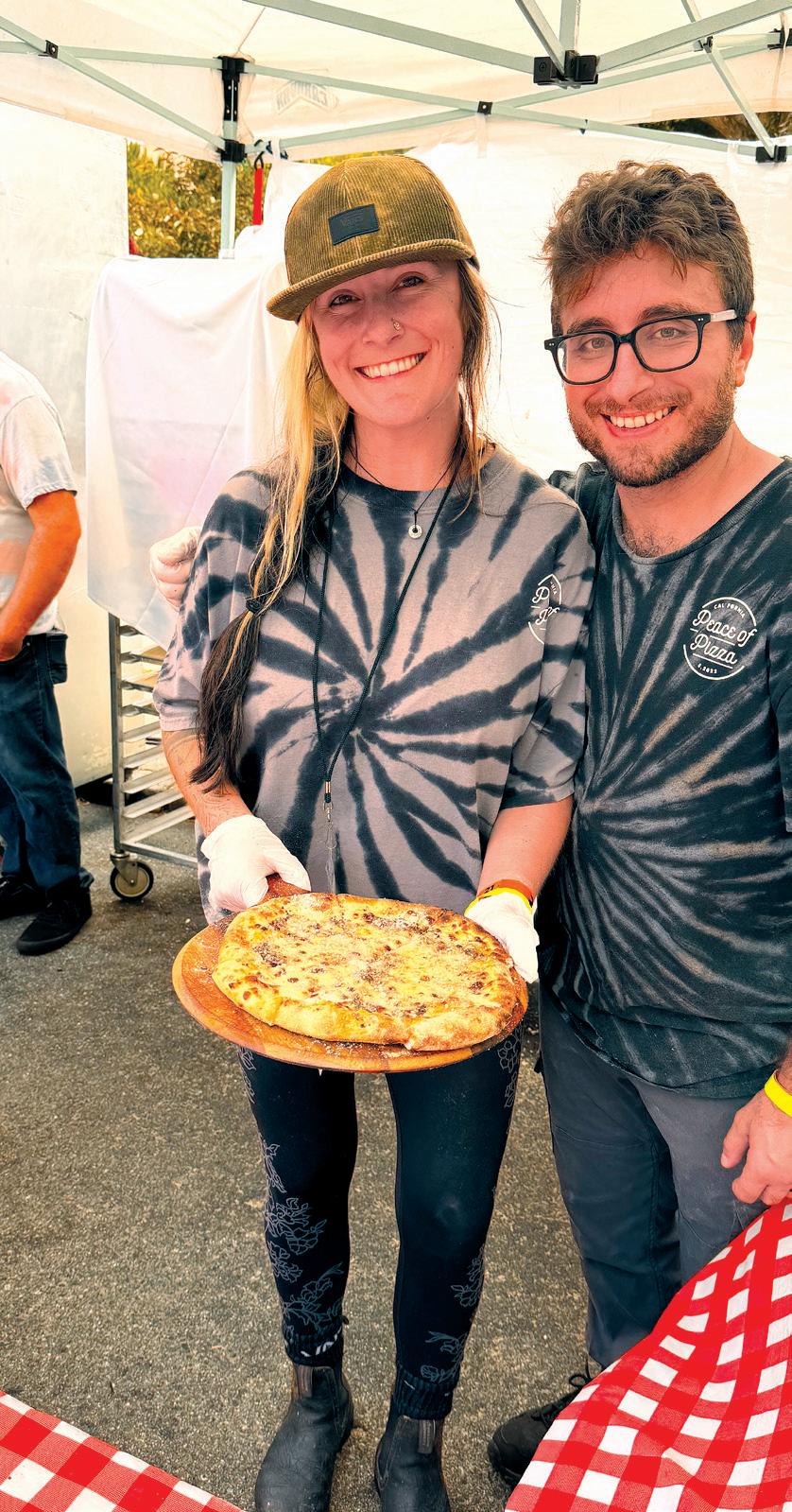
Mel Fucilla | Co-Owner, Peace of Pizza,
Imposter syndrome feels real enough, but Mel Fucilla knows it’s a big, fat lie—for her, anyway. She and her husband, Giovanni, along with a close friend, are partners in Peace of Pizza, a plant-based catering and pop-up operation, and she’s the culinary mastermind behind it. Nevertheless, customers still ask her male partners—not her—about the oven or the dough. Fucilla is used to it, but she knows her worth. “You can do anything,” she says. “No matter how cheesy it is, if you care about it, you will make it work. Imposter syndrome is so real. Does anyone actually know what they are doing? I feel like you wing it and roll with it. You’ll be scared not doing something, and you’ll be scared doing something, so you may as well just do something if you’re going to be scared anyways.”
“You’ll
be scared not doing something, and you’ll be scared doing something, so you may as well just do something if you’re going to be scared anyways.”
Mel Fucilla, Peace of Pizza
What Fucilla wants to do next is open a brickand-mortar pizzeria. In the meantime, she’s wowing vegetarians, vegans and meat eaters alike with pies like the Ringo Starr (mozzarella, grilled caramelized peaches, burrata, crushed pistachios and basil) and their top-seller, the Funky Fungi (a mushroom paté base, white truffles, fresh mozz, Pecorino and green garlic sauce). “We try to stay away from faux meats and focus on using simple things that are good for our health,” she says. “When we say we don’t have pepperoni because we’re vegetarian only, people ask us for our most popular pizza. Good food is good food—it doesn’t matter what it is. It all comes back to having a good crust and a great sauce.”
Read more at PMQ.com/mel-fucilla.

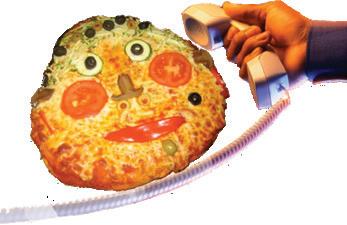

Increase revenue and lower cost
• No Busy Signals
• Call Recording
• Call Queuing / Auto Answering
• Multiple (random) start of call upsell messages
• On hold music/message loops
• Detailed reports—hold times, lost calls etc
• Callerid delivered to POS system
• Auto attendants— ”If you have arrived for curbside pickup press one ”


Protect
• When your Internet fails our cellular backup router keeps your phones, credit card processing and web orders all working.
• The backup kicks in automatically in seconds. So quickly you will not even drop calls in progress when your primary Internet goes down!
• The same router can be used to create chain wide virtual private network to connect your locations.
• SD WAN LTE/LTE A (4G/5G) modems.


Press

Miller Co-Owner, Miller Butler, Los Angeles, CA
Jillana Miller might not be a major name in the pizza community—yet—but celebrities in Los Angeles know exactly who she is. Working, at first reluctantly, for her dad’s private chef business, she began by delivering orders to the rich and famous. When she tried her hand at cooking, everything changed. “My father had one client that just wanted to receive drop-offs, so I started doing that. The client reached out to my father and asked, ‘Who made the food this time?’ My father told him it was me and asked, ‘What was wrong?’ The client said they really liked it and wanted to talk to me about coming in full-time.” Before long, legends like music producer Rick Rubin, Mary J. Blige, DJ Khaled and Kobe Bryant were clamoring for Miller’s handmade dishes.
Nowadays, they’ll have to order from Miller Butler, a catering and pop-up operation Miller owns with her husband, Ahmad. Working out of a ghost kitchen, Miller develops and executes the pizza recipes while also forging business strategy with Ahmad—all while raising their young daughter, Sofia. Miller Butler is a nontraditional company, but, she says, that has “allowed us to really establish our business in a real way before we take big, big steps. Every couple is unique, but for us, it might be the best way.” Meanwhile, she adds, “Being a woman forced me to evaluate the worth of my work. It’s so important as a woman, because if you’re weak about it, they will take advantage of it. [Customers] look at my husband and say, ‘How long have you been a chef?’ And we laugh, and he says, ‘Actually, my wife is the chef.’”
Read more at PMQ.com/jillana-miller.

General Manager, Downtown Pizza Company, Murphy, NC
Running a single-unit buffet restaurant is its own special dance, especially if you’ve tossed the usual boring buffet rules out the window. Lizz Aquarian is so good at it, PMQ featured her on its September 2024 cover. But there’s more to her story. She makes her own rules as a manager, too, although her mother officially owns Downtown Pizza Company. When Aquarian took over, she says, “I wanted to change management in terms of scheduling. I wanted employees to make their own schedules and tell me when they wanted to work. I wanted them to tell me their expectations of us. This essentially diminished the amount of callouts and absenteeism and helped us to eliminate employees who were not performing correctly. It put power back in the hands of the employees.”
But Aquarian exudes her own power, too. “The big thing for me was…showing people that I could be a tiny woman and be a boss. I had to learn how to exercise my authority and hold court.” How does she lead her young staff, many of whom are still in high school? By joining them in the trenches. “You need to work side by side with your crew,” she says. “You have to work harder than everyone. Your crew needs to see you doing the things that they do. This morning, I cleaned the bathrooms. You are no better than them. They are better than you, and you rely on them. You have to sweat, put in the work, and do the hard stuff. Make sure that they see you doing it. Absence from your own kitchen can breed resentment, so there needs to be a balance. They want to see that you care, and you should be there to support them. Even just popping in for 10 minutes can change the course of the evening for the crew. Keep your kitchen culture positive and not toxic.”
Read more at PMQ.com/lizz-aquarian.

Victoria Tiso grew up in the shadow of a pizza giant—her father, John Tiso, is the (now retired) co-owner of the legendary Louie & Ernie’s in The Bronx. Today, she’s building her own legacy with Tori T’s, which opened on Long Island in March 2024. First, though, she had to venture away from pizza and go her own way, coaching college softball for eight years. “I always had this idea that I wanted to do pizza, but I also wanted to have my own sense of being, so I went to take on the sports world,” she says. Over time, “I saw where my career was going in athletics, and I saw I was being overlooked for positions. It was degrading. I thought, ‘Why am I running away from what I know and what I’m good at?’” Back to Louie & Ernie’s she went, this time with a mission: to learn every aspect of the business. But when her dad retired last year, Tiso, who had been instrumental in bringing the old-school Louie & Ernie’s into the 21st century, faced a choice: Stay with the family business or start a new team of her own.
Tiso chose the latter with Tori T’s. Now all of the pressure is on her. “There’s no one telling me no [and] no one telling me yes,” she says. “You’re your own boss, your own worst critic or best critic. And if you’re hard on yourself, you can take anything else coming your way.
“I’m
200% or nothing. I’m never going to give you anything less…. It comes with being a woman, and I want to keep showing the world that I can do it all.”
You’re always trying to form into your own person. You’re trying to step out of that shadow and have your own vision and ideas and bring them to light, with [the family] lingering in the background because you’re always going to be associated with them—because they’re blood—and it’s hard.” But, she adds, “I’m building my own brand….I have my foot on the gas, no stopping. I’m 200% or nothing. I’m never going to give you anything less….It comes with being a woman, and I want to keep showing the world that I can do it all.”
Read more at PMQ.com/victoria-tiso.




Growing up in her family’s pizzeria, Gabby Rodriguez wasn’t so sure she’d end up in the business, too. She really wanted to be a teacher. She even took time off from Pizza Scene to work as a teacher’s assistant in Orlando. But pizza kept calling her name from afar. “I came back because my parents were struggling a lot, and the business wasn’t thriving,” she recalled. “I had always told them I’d come back to help if they needed it. Coming back gave me a different outlook—I found a new love for it.” In the end, that short-lived teaching job “was actually the one thing that helped me realize 100% that pizza is something I want to do.”
But she’s kept her teaching skills sharp by training new employees—after all, there isn’t a single job at Pizza Scene that she hasn’t done herself. “One employee is now 19 but started at 17,” she says. “I taught him how to do everything. In that aspect, I was living my teacher fantasy out. I was able to show him what I’ve learned over the years.” She has developed new skills of her own, too, like adding Sicilian-style pizza to a restaurant best known for its 24” New York-style jumbo pies. “My dad wanted to try Sicilian years ago, but me and my siblings were not on board with it. It’s a different process to do the dough, and he didn’t want to be the only one doing it. We did a lot of test runs back then, and it never came through, but we finally have it down pat. Now all of us are constantly trying to think of different concoctions to put on our Sicilian pizzas.”
Read more at PMQ.com/gabby-rodriguez.
Alexandra Mortati is the founder of Women in Pizza, a nonprofit and global movement that empowers and celebrates women in the pizza industry.
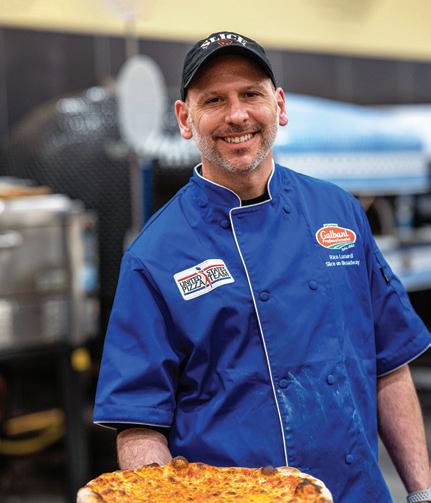
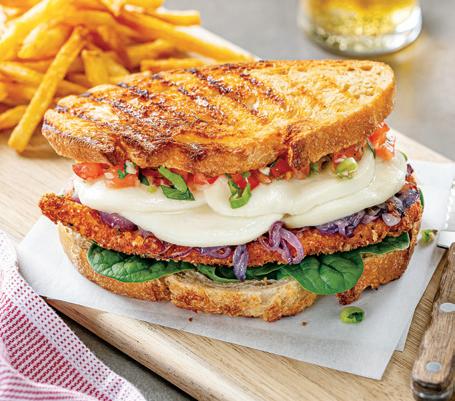
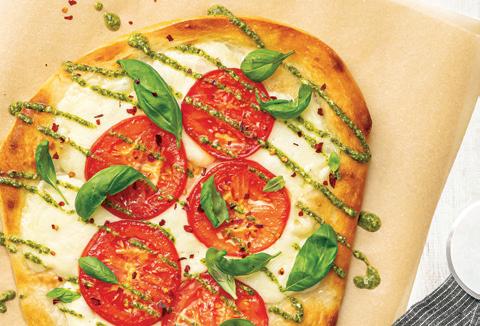
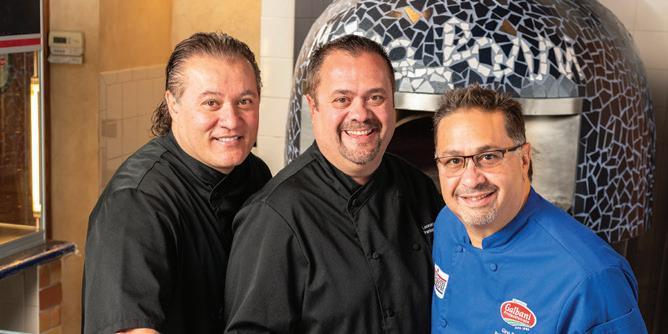
BOOTH #2147



JOIN GALBANI ® CHEESE AT THE INTERNATIONAL PIZZA EXPO ®
It’s more than food—it’s a whole mood with Italy’s # 1 cheese brand at Pizza Expo. From live demos that inspire to pizza acrobatics that amaze, we’ve created a space where taste, energy, and entertainment come together.
Come for the flavor, stay for the fun, and grab some great Galbani cheese samples and giveaways while you’re here! Plus, help us cheer on the Galbani Pro Team during the competitions, including the Galbani sponsored World’s Best Cheese Slice division of the International Pizza Challenge™ and the International Italian Sandwich Championship™.


The restaurant industry is a whirlwind of challenges, and pizzerias often find themselves at the center of the storm. From managing high customer expectations to juggling orders across multiple platforms, staying competitive requires innovative solutions. Enter services like PizzaCloud, which leverage advanced phone and SMS technologies to help pizzerias streamline operations and connect with customers effectively.

According to Datassential, text messaging is rapidly gaining traction in the restaurant space, with nearly 80 percent of consumers expressing interest in receiving SMS updates from their favorite eateries. For pizzerias, where timely communication is crucial, adopting text-based solutions isn’t just a convenience—it’s a game changer for cutting through the chaos and staying ahead of the curve.
Text messaging boasts an impressive 90 percent read rate within just 10 minutes–towering over emails, which see only an 18 percent open rate and are often overlooked for days. “The urgency of text messaging is immediate,” says John Scully, CEO of PizzaCloud. “People read texts right away, whereas with email, the response is much slower, if it happens at all.”
PizzaCloud, now partnered with nearly 2,000 restaurants, offers a full suite of services designed to help restaurants, particularly pizzerias, streamline operations
and increase efficiency. Their IP phone service eliminates busy signals, provides call recording, call queuing, autoanswering features, and supports on-hold music and upsell message loops.
Caller ID integration with POS systems ensures smooth operations, while detailed call reports enhance performance tracking. For internet reliability, their cellular backup internet kicks in automatically during outages, keeping phones, credit card processing, and web orders functional without interruption.
Additionally, their text messaging service enables restaurants to push online ordering, send upsell messages, and communicate directly with staff through group texts. These solutions collectively help businesses stay connected, prevent order losses, and maximize revenue.
The platform offers a self-service portal, but for those who need assistance, their team is available 24/7 to help design the most effective campaigns. “We aim to offer the best of both worlds. Restaurants can manage everything on their own, or we can guide them through the process,” Scully says.
Automated campaigns are another valuable core feature of PizzaCloud, allowing restaurants to schedule texts based on slow times or special promotions. Some even send humorous, light-hearted messages rather than relying on promoting coupons and sacrificing profits. “One of our users sent a message reading, ‘Did you know it’s not a felony to eat pizza on Monday? Order now!’ These messages are fun and engaging, not overly salesy, and people respond to them just as well as coupon offers,” Scully says.
In an industry as fast paced and competitive as the restaurant business, tools like PizzaCloud are revolutionizing the way pizzerias operate. By combining reliable phone services, seamless text messaging, and robust internet backup solutions, PizzaCloud empowers pizzerias to stay connected with customers, streamline operations, and boost revenue.
To learn more about PizzaCloud’s messaging services, visit pizzacloud.net



Increase revenue and lower cost
• No Busy Signals
• Call Recording
• Call Queuing / Auto Answering
• Multiple (random) start of call upsell messages
• On hold music/message loops
• Detailed reports—hold times, lost calls etc
• Callerid delivered to POS system
• Auto attendants— ”If you have arrived for curbside pickup press one ”


Protect against outages
• When your Internet fails our cellular backup router keeps your phones, credit card processing and web orders all working.
• The backup kicks in automatically in seconds. So quickly you will not even drop calls in progress when your primary Internet goes down!
• The same router can be used to create chain wide virtual private network to connect your locations.
• SD WAN LTE/LTE A (4G/5G) modems.


Press
As
BY CHARLIE POGACAR
For pop-up pizzaioli, navigating the transition to a permanent space can require a series of tricky moves—beyond just raising the capital to get started.
WHILE A BRICK-AND-MORTAR PIZZERIA WAS ONCE THE STANDARD ENTRY POINT, a new generation of pizza makers are staking their claim via pizza pop-ups. This approach is not only more affordable; it’s also a cost-efficient way to learn whether or not you enjoy making pizza as more than a hobby—and whether you’ve got the skills to do it professionally. Meanwhile, the increasing quality and ubiquity of portable pizza ovens have lowered the bar of entry into the pizza space.
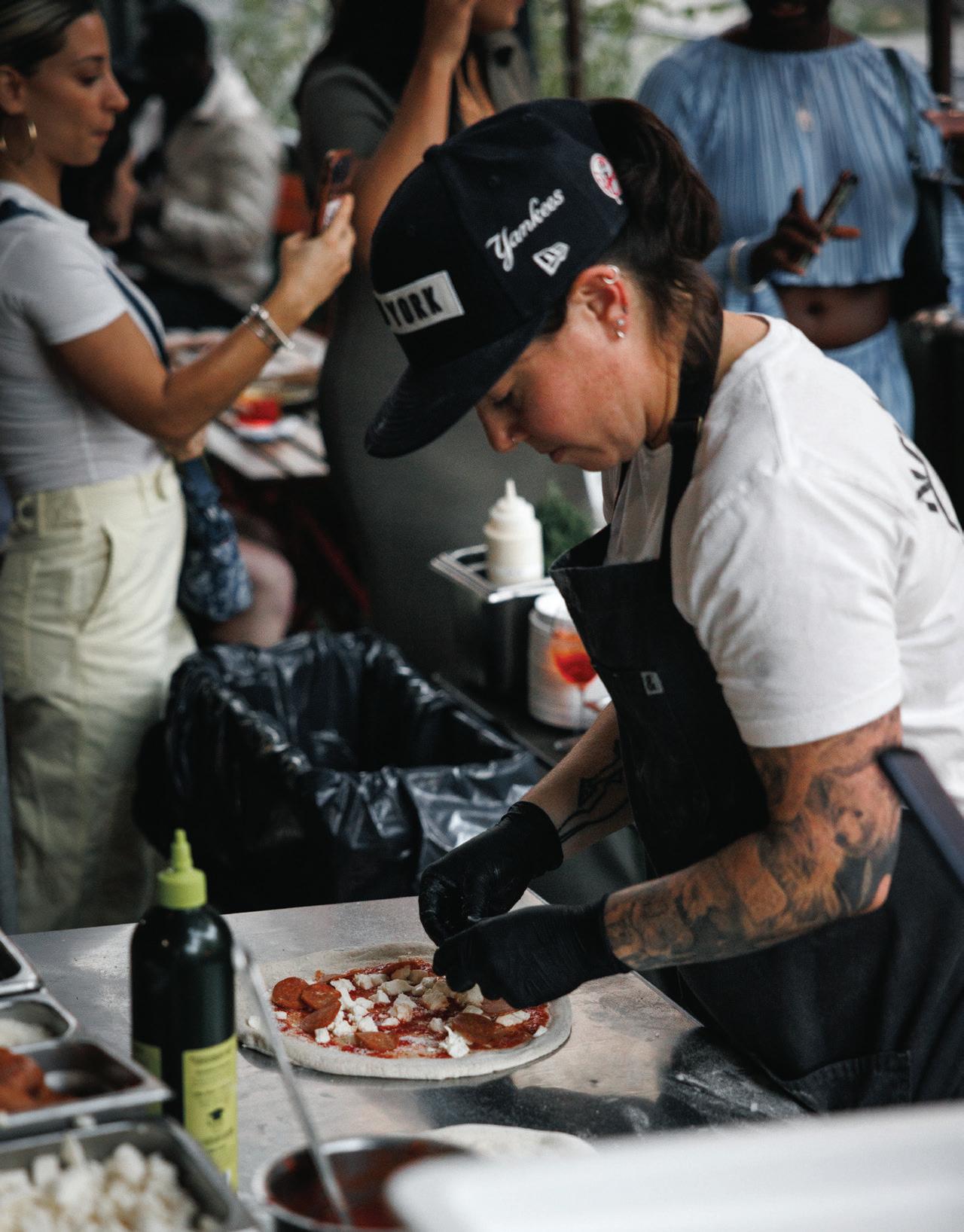
Miriam Weiskind founded The Za Report, her pop-up brand, in the early days of the pandemic. This spring, she is scheduled to open Yum’s of PDX, her first brick-and-mortar restaurant, in Portland, Oregon.

Peyton Smith first entered the pizza game via Forno Moto, a mobile unit that included a Fire Within oven on top of a trailer. He ran Forno Moto for several years prior to opening Mission Pizza Napoletana, an osteria in Winston-Salem, North Carolina, that has appeared on 50 Top Pizza’s list of the best U.S.-based pizzerias every year since it debuted.
“The best thing about [starting with a pop-up] was that I learned very cheaply that I really like making pizza for a living,” Smith says. “I didn’t have to spend a quarter- to a half-million dollars to learn that I don’t like it. I mean, how much would that suck?”
Pizza pop-ups can also be an inexpensive way of establishing brand recognition. Domenick Calise founded Bucky’s Pizza in Chatham, New Jersey, after he was laid off from his job in talent acquisition. Further complicating matters, he and his wife were about to welcome their first child. A pizza making hobbyist, Calise decided to launch Bucky’s as a pop-up and quickly found success. The concept was regularly booking several gigs per week as Calise began eyeing potential space to call his own.
“Looking back, I wanted to go straight into a brick-andmortar,” Calise says. “But, if I’m being honest, I think the smart move for us was to do the pop-up first, just because it gave us an opportunity to build a following.”
For Miriam Weiskind, founder of The Za Report, not only did running pop-ups early in the pandemic help

establish brand recognition—it also helped her figure out where she wanted to open a physical pizzeria. Weiskind split time doing pop-ups between New York City and Portland, Oregon. She quickly found that, while she made a lot more money at the pop-ups in New York, there was less competition in the Pacific Northwest and, thus, more demand for her neo-Neapolitan pies. Weiskind is scheduled to open up Yum’s of PDX, her first brick-andmortar location, this spring.
“It would have cost me well over $1 million to open a pizzeria in New York City. And there, it’s a game of selling as much pizza as possible to survive.”
Miriam Weiskind, The Za Report
“It would have cost me well over $1 million to open a pizzeria in New York City,” Weiskind says. “And there, it’s a game of selling as much pizza as possible to survive. [In Portland,] I could really focus on the quality of my product and getting a firm foundation so that, if I want to open up another one or two more [locations], I have firm ground under my feet to do so.”






JOSHUA LOU/BUCKY’S PIZZA

But pop-ups have their downsides, too. For one thing, booking events can become a full-time job in its own right. With a pop-up, you’re also often at least partially relying on another partner business to bring in the foot traffic—and the weather is a factor that’s always beyond your control. Plus, the revenue you make at a pop-up is often severely limited. “I think often we all get too fixated on the top line,” Smith says. “What really matters is the bottom line…but, with that said, the opportunity for top-line revenue in a brick-and-mortar versus the opportunity for topline revenue at a pop-up—those things are not even remotely on the same planet. From the [number] of days you can operate to how much you can feed somebody, it’s [exponentially different].”
One of the biggest challenges of pivoting from a pop-up to a brickand-mortar, of course, is funding. Even for a high-profile pizzaiola like Weiskind—who has nearly 23,000 followers on Instagram and appeared on the Food Network’s Chopped—raising capital can be a challenge. In fact, Weiskind heard 103 nos from investors before she got one to say yes. In all, only a handful of the 115-plus people she pitched agreed to be silent investors in Yum’s of PDX. In total, about a half-dozen investors will combine to own 18% of her business.
Perhaps one of the reasons Weiskind kept getting turned down was her unconventional pitch to investors. She recalls, “I told them, ‘This
Bucky’s
“The opportunity for top-line revenue in a brick-and-mortar versus…a pop-up—those things are not even remotely on the same planet.”
Peyton Smith, Mission Pizza Napoletana
is not about building your portfolio to make a lot of money. This is about building your portfolio [in a way] where you’re helping someone build their beautiful dream restaurant in Portland, and [as for] the money, you’ll be paid back in three years. So you’re not losing money, and the profit you make from this each year will be the money you use to buy Christmas gifts for your kids.’”
But appealing to their sense of altruism helped assure Weiskind that the investors were aligned with her vision rather than simply sniffing around for a way to make some easy money. In fact, she memorably turned down one investor who was willing to write a large check because they saw the makings of a chain and wanted to own the pizzeria’s intellectual property.
“I’m not here to get rich,” Weiskind said. “I’m here to bring wealth to the community. Sure, I need money to pay the overhead and to pay my staff, but I want to be a part of this community, because community is everything to me.”
There’s another problem to consider if you’re pondering the transition from pop-up to brick and mortar: No matter how much time and money you think it will require, it will probably require more. As Smith explains, everyone—from local permitters to contractors to landlords—are working on their own timeline. Fitting all of the puzzle pieces together requires a lot of politicking, problem-solving, sweaty equity and, perhaps, kind friends.
Calise relied on friends and family to help fund Bucky’s Pizza. But he wasn’t borrowing $1 million—he found an existing pizzeria’s lease available for just $28,000. There were upgrades that needed to be done, but that’s where some manual labor came into play. Calise repainted the
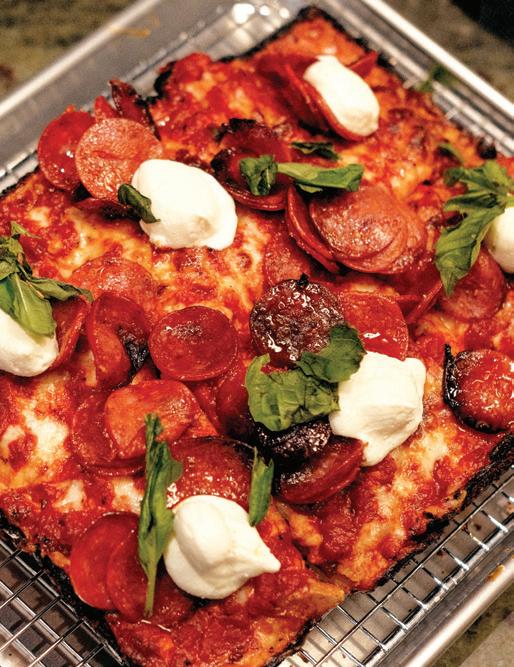
restaurant, put in some new floors and revamped the walk-in cooler. In all, it cost about $125,000 to launch Bucky’s Pizza, which opened its doors in October 2024— just over a year after Calise launched his pop-up.
“That process [of redoing the walk-in] took way longer than it needed to,” Calise notes. “I thought it would take about two months to turn around, and it ended up taking more like four months. So I was constantly going back in my head—like, if I had just hired someone to do it and I was able to open in two months instead of four, would I have been better off? But, you know, that’s why hindsight is 20/20.”
Even with all of these challenges, each owner-operator mentioned here has no doubt that they made—or are in the process of making—the right decision. For Weiskind, the decision was made easier knowing that pop-ups were, in a way, the perfect stepping stone to running her own restaurant.
“I think that, having been in the pop-up scene, one of the greatest attributes of doing pop-ups is that you have to be able to pivot on a dime,” Weiskind says. “You have to be able to pivot and just keep going. I think that’s going to be hugely beneficial in the restaurant setting, even if it’s an entirely different set of circumstances.”
Charlie Pogacar is PMQ’s senior editor.
Pizzerias are currently grappling with significant challenges, notably staff shortages and escalating labor costs. As of early 2024, staffing levels remain 3.6 percent below pre-pandemic figures, with approximately 450,000 open positions unfilled, according to an OpenTable labor report. Additionally, a wage report conducted by The U.S. Bureau of Labor Statistics found that labor scarcity has driven average hourly wages up by 29 percent between 2020 and 2023, intensifying financial pressures on establishments.
Compounding these issues, 98 percent of operators report higher labor costs are adversely affecting their business operations, according to the National Restaurant Association. These intertwined challenges of workforce shortages and rising labor expenses are compelling restaurants to find innovative solutions to sustain operations and maintain profitability.
For pizza restaurant operators dealing with these challenges, Ovention® ovens provide innovative solutions tailored to their needs. Ovention’s versatile oven line—including the Matchbox®, Shuttle®, and MiLO® ovens—streamlines pizza preparation with advanced technology ensuring consistent, high-quality results with minimal oversight.

These ovens offer precise temperature control, customizable cooking profiles, and ventless operation, making them a game changer for busy pizzerias. “Ovention ovens come with touchscreens that allow recipes to be pre-programmed,” says Chef Joe Arvin, the corporate chef for Ovention ovens. “This reduces the need for highly skilled culinary labor. For example, the oven can be used to cook a pizza perfectly with the touch of a button.”
The pre-programmed recipes offer consistency across daily shifts and multiple locations, delivering the same highquality results regardless of who is operating the equipment. “Consistency is key,” Arvin says. “Pizza made in Georgia will taste the same as one made in Kentucky. This allows operators to scale their menus without increasing staff. They can prep food in bulk and rely on the Ovention ovens to handle the cooking consistently.”
Customization is crucial in today’s competitive restaurant industry, allowing pizza operators to tailor their offerings to meet diverse customer preferences and stand out in a crowded market. “I offer customized settings for clients based on their specific preferences,” Arvin says. “For example, I can adjust settings to achieve the exact crust texture or cheese caramelization they want. This standardization means anyone can operate the oven with minimal training.”
Ovention ovens are not just designed for exceptional pizza; their versatility extends to a wide range of menu offerings, making them a valuable asset for any pizzeria looking to diversify. From perfectly baked sandwiches to appetizers like wings, Ovention ovens can handle it all. “Our ovens can roast, bake, air fry, and more—all in one unit,” Arvin says. “They save space and energy by keeping heat contained, thanks to the fact they’re 100 percent ventless and don’t require an oven hood.”
In an industry where challenges like staff shortages and rising labor costs demand innovative solutions, Ovention ovens stand out as a game changer for pizzerias. Arvin succinctly summarizes: “Consistency and automation are the future of kitchens, and that’s exactly what we deliver.”
To learn more about Ovention’s innovative technology, visit oventionovens.com
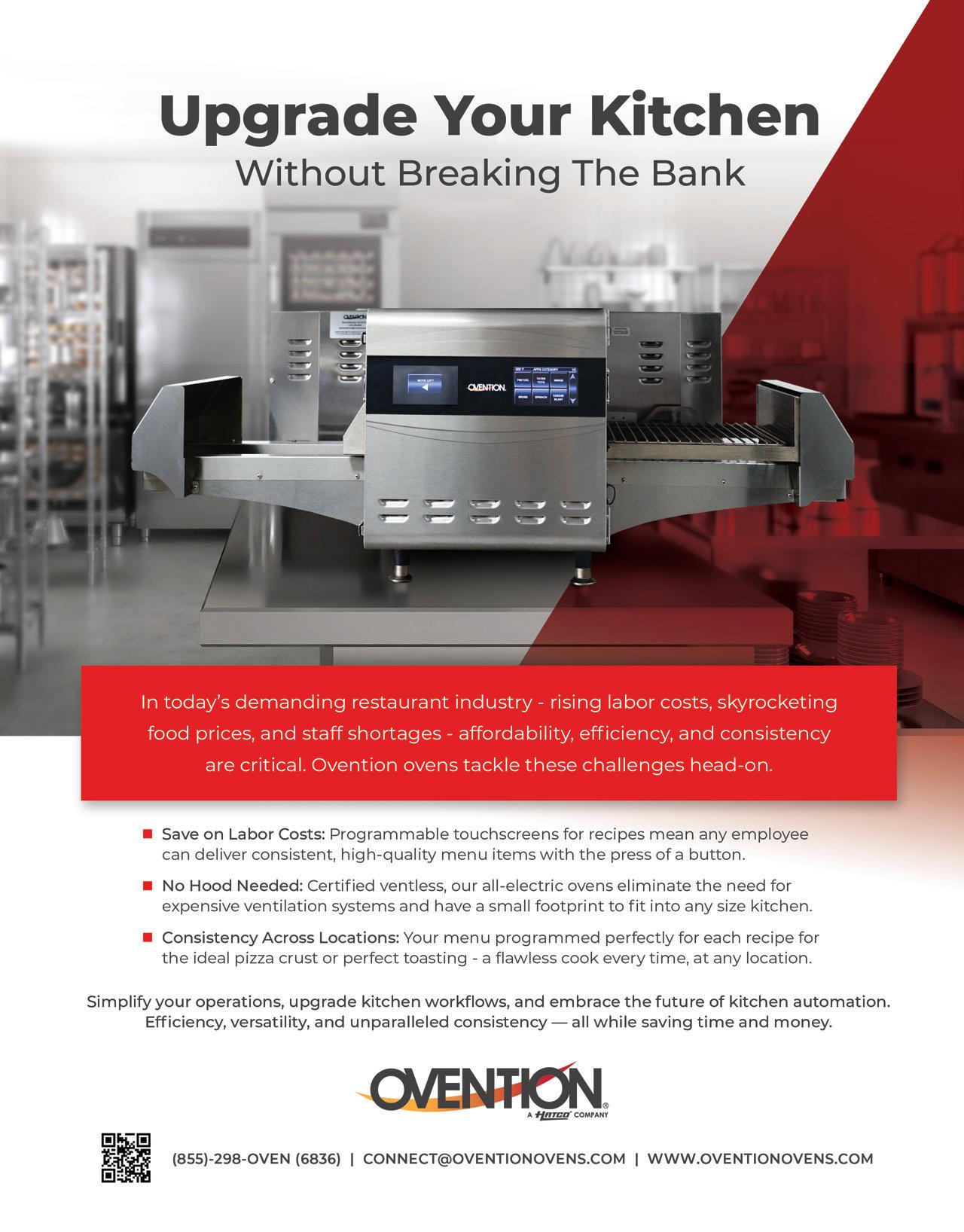
The leading pizza chains make delivery and carryout look easy, but what do customers think about their service? We asked Intouch Insight to find out.
BY CHARLIE POGACAR
IN THE POST-PANDEMIC ERA, DELIVERY AND CARRYOUT (DELCO) continue to bolster the pizza community. For many chains, it’s practically the be-all and end-all. And brands like Domino’s and Papa Johns make it look so easy. But what do their customers think about their service? And how can independent pizzeria owners better compete with the big boys?
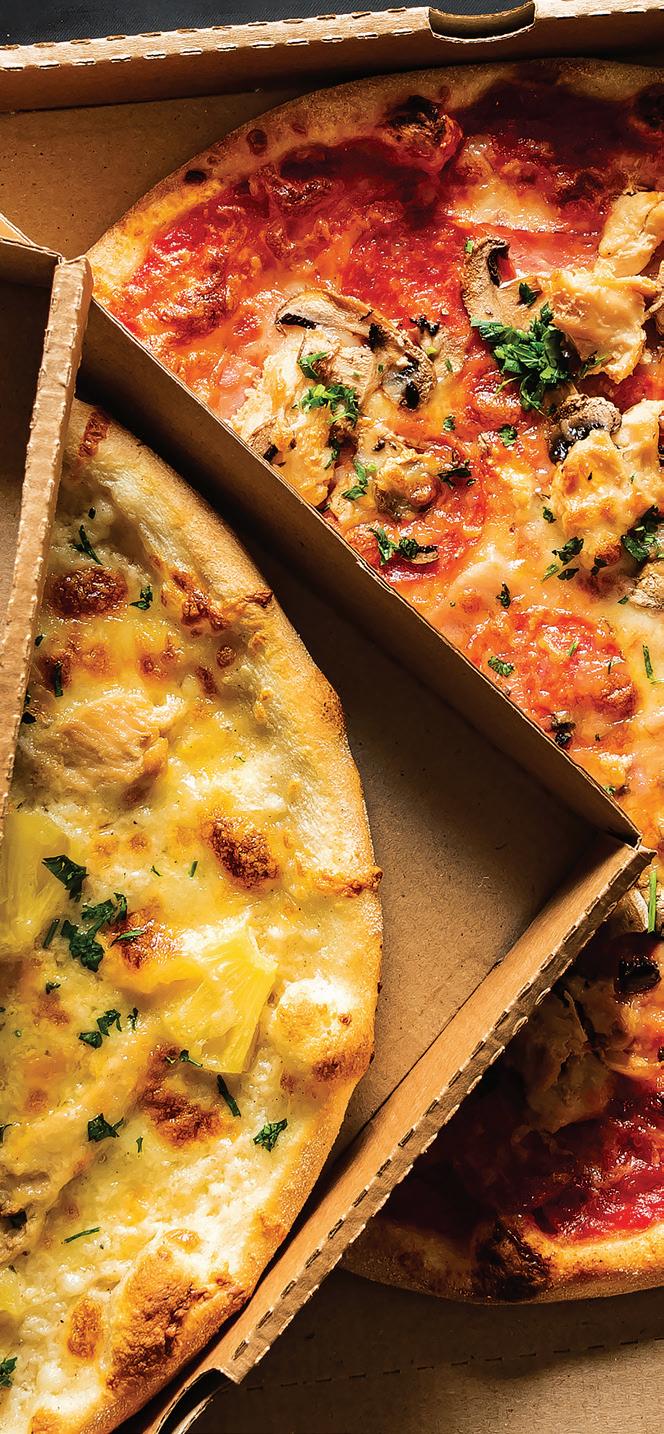
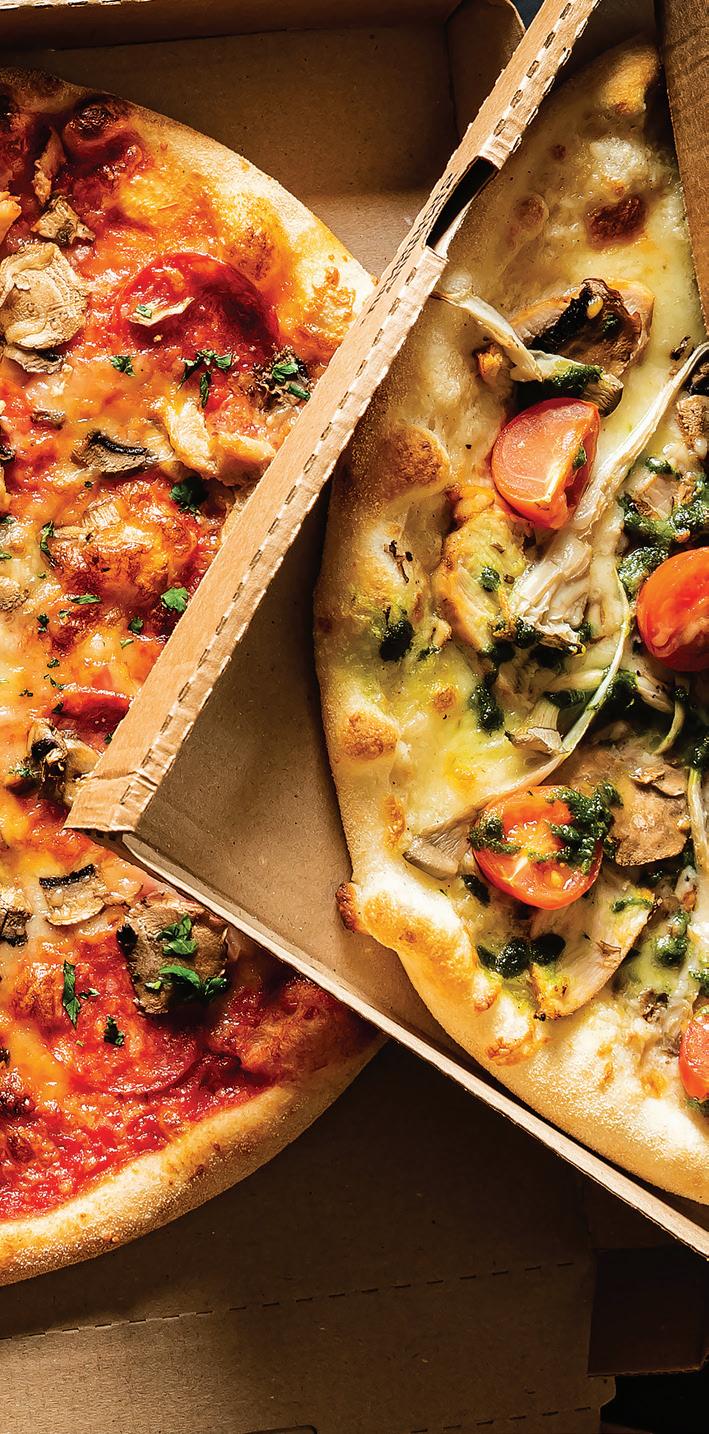
The PMQ Pizza DELCO Report, conducted in partnership with research firm Intouch Insight, uncovers how the leading chains are serving their offpremises customers—what they’re doing well and where they might be lacking. The report is based on 660 mystery shopping transactions, evenly split between 12 different brands—10 pizza and two convenience store chains. The findings could point independent operators in the right direction—by showing them how to beat those brands at their own game.
Between third-party aggregators and new technologies, takeaway and delivery have changed a lot in the last few years. For example, pizzerias—both chain-affiliated and independents—have implemented tools like AI-driven voice ordering to offset labor challenges. It’s clear this technology is “working,” at least in a basic sense, but, in some cases, it appears to have a negative effect on order accuracy.
The report found that order accuracy hit 97% when a DELCO order was taken by an
employee, compared to 88% when the entire call was automated. While both numbers are high, consider that the robots got more than one in 10 orders wrong. And there’s further evidence that human-led order taking makes a difference: Order accuracy was 92% when a call was initially picked up by an automated service but was ultimately transferred to and completed by an employee.
For phone orders, how the call was taken impacted order accuracy.
• Order accuracy scored 97% when the entire order was taken by an employee.
• Order accuracy scored 92% when the call was initially picked up by an automated service but transferred to an employee.
• Order accuracy scored 88% when the entire call was automated.
These results suggest that some voiceordering technologies used by top chains have room for improvement.“Many of the technologies we’ve evaluated in the broader quick-service space have had a positive impact on the customer-service experience,” said Sarah Beckett, vice president of sales and marketing at Intouch Insight. “So the fact that the voice ordering wasn’t nearly as effective as the oldschool, ‘pick up the phone and talk to a human being’ way of doing things—that really jumped out at us.”
Beckett pointed out that voice-ordering technology tends to work better when there is a confirmation board in front of the customer— that is, when you’re sitting in the drive-thru and a screen is populating your order in real time. That confirmation board may be a key piece that’s missing from automated call-in orders.
Third-party delivery, meanwhile, has become table stakes for many

pizza chains over the past five years. But it won’t surprise some independent operators that third-party delivery can have an adverse impact on the guest experience. Intouch Insight’s mystery shoppers reported 19% higher overall satisfaction with a pizza brand’s own delivery drivers when compared to third-party gig workers.
In fact, first-party delivery was a better experience for customers in several different areas. Customers who received first-party delivery reported getting their orders delivered 2 minutes and 38 seconds faster; unsurprisingly, customers’ satisfaction with the speed of service was 8% higher. Their delivery driver was also 11% more likely to have been friendly, and their food temperature score (a binary hot-or-not rating) was 11% higher.
Overall, customer satisfaction was much higher with carryout as opposed to delivery. A whopping 90% of customers enjoyed their carryout experience, compared to just 78% of customers who approved of the delivery service (a stat that combines both first- and third-party delivery).
Some voice-ordering technologies used by top chains have room for improvement.
Finally, and importantly, overall satisfaction with a carryout experience was 73% higher when the pickup employee was friendly versus unfriendly. Similarly, for call-in orders, overall satisfaction was 65% higher when the order taker was friendly versus unfriendly. Those numbers point to a huge opportunity for independent operators—but more on that in a bit.
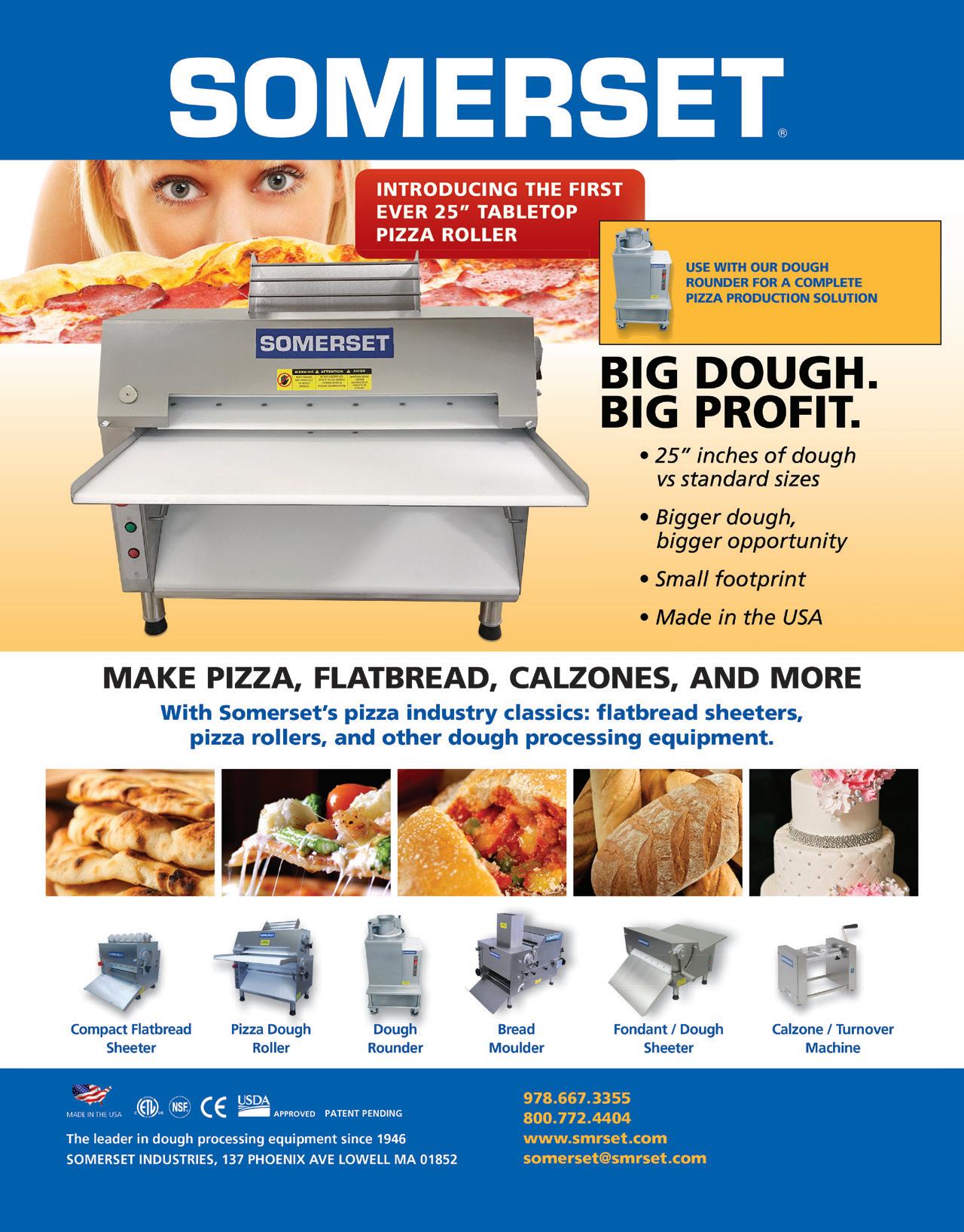
Fast-casual pizza brands, once the growth darling of the industry, had a tough year in 2024. MOD Pizza nearly filed for bankruptcy prior to being sold last summer. In that same year, a Blaze Pizza executive told QSR magazine that the brand was “hungry” to get “back on track” after losing momentum due to a cocktail of pandemic-induced woes.
The DELCO Report identifies at least some of the issues facing these chains. Of the 10 chains involved in the study, MOD and Blaze tied for last in terms of overall satisfaction (68%). That was a far cry from even the third-to-last brand, Donatos, which scored an 82% approval rating.
Both MOD and Blaze struggled in multiple areas. For speed of service, Blaze Pizza scored a satisfaction rate of 81%, while MOD recorded a 75% satisfaction rate. In a related statistic, Blaze and MOD recorded the poorest scores (69% and 64%, respectively) in terms of how often the customers were pleased with the temperature of the pizza once it reached them via delivery. Finally, both brands trailed the pack in terms of order accuracy (90% for MOD and 87% for Blaze Pizza).
It is perhaps unsurprising, then, that MOD and Blaze were the two brands that
most heavily relied on third-party delivery to fulfill orders. For MOD, 54% of the delivery transactions were via a third party, while that figure was 58% for Blaze orders. The big takeaway for independent operators? First-party delivery is almost certainly a better option. But if that’s unrealistic, Beckett says, there are still ways to improve your third-party delivery orders.
“If you’re going to use third-party delivery services, think about ways to mitigate potential challenges on your end—for example, the temperature of the food upon arrival at your customer’s home,” Beckett says. “To maximize the potential of this channel, are there things that can be done operationally that are in your control? So maybe that means doing things differently, timing-wise, in the kitchen, or figuring out how to make sure pizza boxes aren’t sitting there getting cold, waiting for a driver.”
The big takeaway for independent operators? Firstparty delivery is almost certainly a better option.
As an independent operator, what can you actually do with this information? Fortunately, the team at Intouch Insight has vast experience parsing data and turning it into actionable insights. Beckett pointed to some pivotal findings regarding friendliness. To properly set the stage, each mystery shopper was asked a simple yes or no question: “Was your delivery driver (or the team






members you interacted with when picking up an order) friendly?” The study found that shoppers were 67% more likely to deem their delivery driver friendly when the driver smiled and 57% more likely to say the same when the driver provided a parting remark.
The results with carryout were similar: Shoppers were 40% more likely to rate the interaction as friendly when team members greeted them upon entry and 54% more likely to rate it as such when employees smiled. These are coachable habits—and an area where independent pizzeria operators can find an edge.
“Time and time again, we see friendliness being one of the factors that has the greatest impact on the overall customer experience,” Beckett said. “And this is an area where, in our studies, we typically see that smaller operators excel. It’s in those positive interactions—smiling, greeting customers, offering those positive remarks— that they can have an impact on the overall satisfaction metrics and build those personal connections with their customers. So if you can hone in on those things, you can continue to differentiate yourself from the big chains.”

From our industry-recognized studies, like the Annual Drive Study, to our CX and mystery shopping solutions, we help b enhance their operations and improve guest experience.
NEW for 2025! The Intouch In Pizza DELCO Report, in partn with PMQ Magazine, delivers data you need to stay ahead o evolving trends. For decades, Intouch Insight has provided the restaurant operators with insights they need to grow.

Scan this QR code to get your slice of insight → letschat@intouchinsight.com | intouchinsight.com


Polly-o mozzarella is the best part of the pizza



Developed specifically for New York style pizza, our new loaf is the perfect combination of quality and convenience. With a superior melt, stretch and browning, this formula is full of flavor with less residual oil.
CHEESE, Made in New York since 1899
email info@polly-o.com to request samples
Experts share their journeys toward—and most helpful tips for creating—an unforgettable crust.
BY TRACY MORIN
WHEN IT COMES TO PIZZA, “PERFECT” IS IN THE EYE OF THE BEHOLDER. A diehard Detroit-style fan might be appalled at the thin crisp of a bar pie, while a Neapolitan traditionalist may bristle at a deep-dish Chicago slice. The one commonality among all pizza makers is that they want to create the perfect pie for them. In their own words, here’s how three acclaimed pizzaioli landed on their visions of pizza perfection.

Thomas Garnick prefers a high-hydration dough, around 68%, with a long, cold fermentation, to achieve a light, airy crumb.
THOMAS GARNICK

Thomas Garnick, owner, Sapore Concepts, Denver, CO
Choosing the perfect dough requires careful consideration—it must stand up to the toppings and withstand the chosen oven. The pizza maker must envision the final bite: Will it be light and cracker-crisp, a thick pillow of luscious dough reminiscent of fresh bread, or something in between? The beauty of pizza lies in its simplicity. Flour, water, salt and yeast come together to create an infinitely complex interplay of taste, texture and structure.
Fermentation is the backbone of crust development, and time is its secret ingredient—often overlooked by both novices and professionals. With enough time, fermentation science works its magic, enhancing flavor, texture and even digestibility. The alchemy of extended fermentation breaks down complex carbohydrates into simple sugars, creating a crust that is both flavorful and lighter on the digestive system.
For those tight on time or space, a pre-ferment can mimic the results of long fermentation. By mixing a base portion of the pre-fermented dough, you can achieve a similar taste, texture and structure in less time. Popular pre-ferments include poolish, biga and pâte fermentée. Flour selection is also critical, as it drives texture and taste. Understanding protein percentages is key, because they directly influence the dough’s performance. A reliable mix of performance grain for consistency and artisanal flour for a unique, robust character often yields the best results. Combining these flours ensures a finished crust with both dependability and depth.
Balancing lactic and acetic acids in the fermentation process is essential. Lactic acid imparts a traditional oven-baked flavor, while acetic acid adds a tangy, sourdough-like quality. Adjusting this balance allows for customization based on your desired flavor profile.
My personal favorite style is what the “cool kids” call neo-Neapolitan. It’s crisp enough to stand up to the weight of the toppings, yet soft and supple when bitten. There’s a satisfying crunch, followed by a slight chew that melts away after a few motions of the jaw. The crust features a light, airy crumb and leopard-like charring that showcases the intensity of the oven’s heat, helping the cornicione rise to create a delicate, airy texture.
To achieve this, I prefer a high-hydration dough (around 68%) with a long, cold fermentation. Ideally, the dough undergoes bulk fermentation in the refrigerator for 48 to 72 hours, followed by another 12 to 24 hours of fermentation after portioning.
My go-to flour blend includes a 14% protein content to support extended fermentation. I often mix 10% to 20% local heritage grains with a red hard wheat commodity flour for balance. A large-grain sea salt at about 2.4% adds a nuanced flavor, while a controversial addition of 2% extra-virgin olive oil blend enhances mouthfeel and suppleness.
Finally, the dough needs to hit a very hot oven: 750°F on the deck and 950°F or more in the dome. I prefer wood-fired ovens, but any electric or gas oven reaching those temperatures will suffice. A two-minute bake gives the perfect bite—not too soft or soupy, with the cheese and sauce perfectly homogenized and set.


Alexandra
Castro, owner, Everything Dough, Stamford, CT
A perfect pizza depends on the baker’s vision and the style they aim to create. In my case, I’m inspired by Neapolitan-style pizza, which is the type I make and sell. I use only four ingredients:
• 00 flour: 100%
• Water: 62%
• Salt: 2.5%
• Active Dry Yeast (ADY): This depends on the season or weather and can range from 0.03% to 0.06%.
00 flour can withstand high temperatures, making it ideal for Neapolitan-style pizza. The salt should be finely ground so it dissolves quickly and evenly. I use ADY because it’s easier to store, lasts longer and is more accessible than the fresh version. Filtered water is best
“For a long time, I was a fan of cold fermentation, but lately, I’ve been experimenting with room-temperature fermentation, and I like it more.”
Alexandra Castro, Everything Dough
for making dough, as it ensures the cleanest and purest results, so investing in a water filter is a good idea.
To start, I mix the water with the yeast. This ensures that the yeast is evenly distributed throughout the dough, allowing it to reach its full potential. Next, I add the flour in two parts. Once a shaggy mass forms, I incorporate the salt. After the salt is fully mixed in, I add the second portion of flour. I knead the dough for 10 to 15 minutes, or until it has a silky texture and forms a pumpkin shape. If you hear the dough releasing small pops of air, that’s a sign it’s ready.
Fermentation is one of the most crucial steps in making dough. Whether you opt for room-temperature or cold fermentation, the key is ensuring the dough ferments properly before use. Proper fermentation results in better color, shape, texture and digestion of the pizza.
For a long time, I was a fan of cold fermentation, but lately, I’ve been experimenting with room-temperature fermentation, and I like it more. What used to take me four days with cold fermentation now takes me just a day and a half. The key to room-temperature fermentation is reducing the amount of yeast to prevent overproofing or premature proofing. The science behind this is simple: For cold fermentation, you use slightly more yeast, because the dough needs to keep growing while breaking down complex structures in a controlled environment. In contrast, for room-temperature fermentation, you use less yeast to accommodate the faster proofing process.
Shaping the dough is essential for maintaining the structure and retaining all the gases created during the proofing stage. Then I bake my pizzas at 850°F for about two minutes. Once I’ve launched the pizza into the oven, I let it cook until it starts to rise, then rotate it until it’s done.





















































































































Louise Joseph, owner, Dough Girls, Greenwich, CT
A lot of people compare my dough to Neapolitan, but I don’t follow any of the classic Neapolitan rules or ingredients—it’s Neapolitan the way I do it! I like to work with very pure ingredients, like unbleached and unbromated flour, and I don’t add anything to the dough that doesn’t need to be added, like sugar. Less is more. I use commercial yeast, not a starter, and I do a shorter fermentation, which works better for me.
I knew what I wanted my pizza to look like before anything else, because people eat with their eyes. You need the best foundation possible, and for me that’s the dough. While my truck was being built out, I worked on my dough for three years. I wanted it to be light and airy with a good chew, not thin and crispy. I made a lot of mistakes, like leaving the dough out at room temperature and having it explode everywhere. I invested in a pizza steel to replicate the wood-fired oven without needing to stoke the oven every time I wanted to play with the dough. Once I got it near the point I wanted, I fired up the oven.
“The biggest issue working in a truck is that the dough is so fragile, and from the walk-in to the kitchen to the truck, that’s already three different temperatures.”
Louise Joseph, Dough Girls
The biggest issue working in a truck is that the dough is so fragile, and from the walk-in to the kitchen to the truck, that’s already three different temperatures. Once you get to your venue, it’s another temperature; once you open the awning, that’s another. It becomes challenging. I’m watching the weather for the temperature and humidity, and I’m constantly babysitting the dough: Do I need to pull out the dough earlier or keep it in the refrigerator longer?
After nine years, I know how to work with it, how to shape and open the dough. On a hot, humid day, it’s proofing more, so I’m more gentle with it. If it hasn’t proofed enough, I dimple it with my fingertips and let it sit, because it’ll have snap-back if it’s too cold. I’ll let it rest 15 to 30 seconds and do it again to get the desired size.
A wood-fired oven is also challenging. On colder days, it takes longer to heat up. You have to make sure the dome is hot, the air is circulating, and the floor is hot enough (but not too hot). I eat a test pizza every time—sometimes two. I look at the fire to decide what size wood I need to add. And you have to rotate the pizza so it doesn’t burn. Sometimes it’s tricky to get an even bake, even to this day!
Tracy Morin is PMQ’s associate editor.

Alexandra Castro, owner of Everything Dough in Stamford, Connecticut and a speaker at PMQ’s 2024 Pizza Power Forum, points out the solutions to common problems when making Neapolitan pizza:
• Soupy center: Use a thicker sauce or less of it. Bake the pizza a little longer at a lower temperature.
• Unmelted cheese: Bring your ingredients to room temperature before baking.
• Gummy crumb: Bake for longer at a lower temperature to ensure even cooking without burning.
• Baking takes longer than normal: If you’ve been baking multiple pizzas, allow the oven to recover its heat.
• Top of the pizza is underdone: Move it closer to the flame to “kiss” the top.
• Burnt bottom: The oven floor may be too hot.
Editor’s note: In the online version of this story, Thomas Garnick, owner of Denverbased Sapore Concepts, shares more solutions to common dough mistakes. Check it out at PMQ.com/ tips-for-a-better-crust.



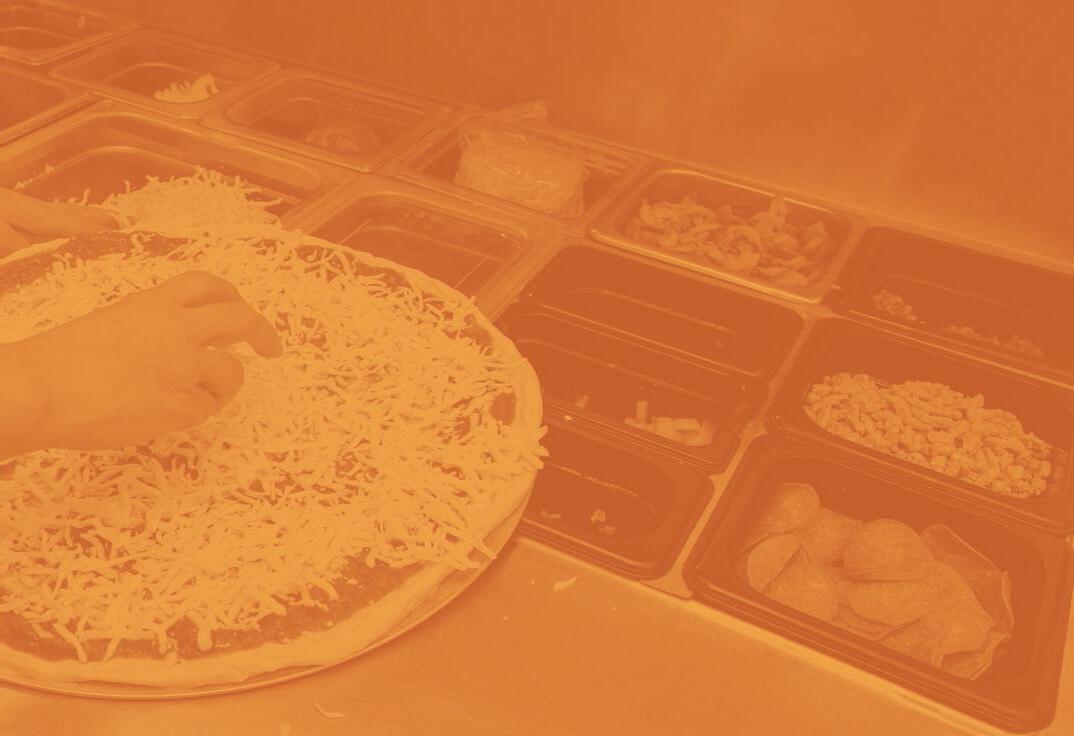

G Tray ’s dough boxes are the indus tr y s tandard in ofing and s torage in piz za kitchens worldwide. But not itchens are created equal Our new mini dough boxes half the size– designed for smaller kitchens and cramped kspac es with unmatched s trength and durabilit y
berglass s trength and durabilit y outlas t s plas tic
ptimal dough protec tion and safe s torage eal for s toring, proofing, and c ooling ecure s tacking on s tandard MFG dough boxes
Won’t bend, dent or sag
Take Your Chances & Win Big!






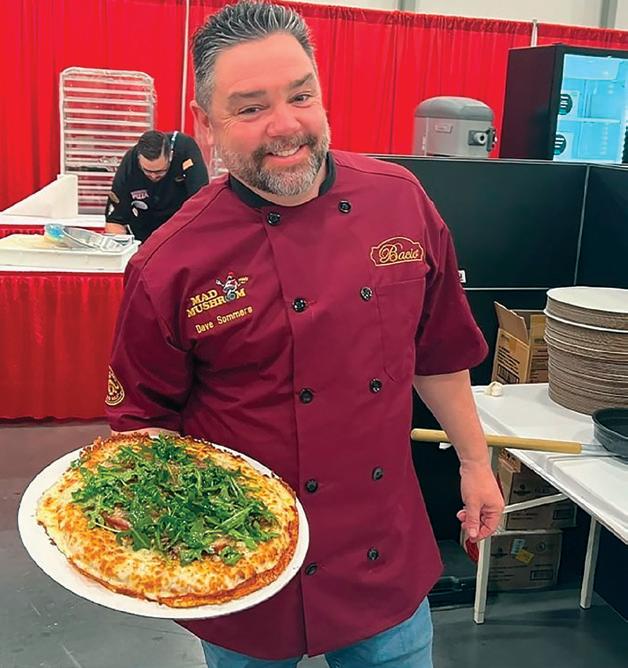
All rise for pizza competition judge David Sommers of Mad Mushroom, who’s helping shape global pizza tastes—when he’s not commanding the spotlight himself.
BY BRIAN HERNANDEZ
AS A MEMBER OF THE U.S. PIZZA TEAM (USPT) since 2012, David Sommers, owner of Mad Mushroom in West Lafayette, Indiana, has been spinning dough, winning awards, judging pizza competitions and building pizza dreams since 2005. What’s next? He’ll serve as a judge for the Pizza Champion Cup Norge in Norway this month. Here, Sommers chats about his journey, judging expertise, and transition from competing in to critiquing pizza contests.
Brian Hernandez: Tell us about Mad Mushroom and your USPT career.
David Sommers: I started in the pizza industry as my first job way back in the mid-1990s with one of the large chains—because they would hire me. I went on
to college at Purdue to study restaurant management, started working for Mad Mushroom as a sophomore in ’94 and stayed with it through graduation. I ended up purchasing the company from the original owners in 2001. My partners and I have been running it since then. We’ve got six locations now—three in Indiana and three in Kentucky.
I got into competitions in ’05 or ’06. It was mostly on the athletic side at first—fastest pizza maker, largest dough stretch and a little freestyle. Traveling to Parma in 2013 or 2014 was the first time I entered the culinary side. From traveling with those [USPT] guys and going to all those places, I learned how to do that better. So I’ve been [competing in culinary] for a little over 10 years now.

Hernandez: When did you begin judging?
Sommers: My first event was in ’21 in Atlantic City. I still remember it as one of my least favorite judging moments. I was judging the calzone category and tried what was probably the third or fourth calzone that just wasn’t finished [baking], and it had shrimp in it. It’s the only time I’ve ever had to spit something out. It was a good lesson in making sure everything is tested before presenting it to judges. Since then, I’ve done numerous USPT-hosted events and local competitions in the Indy and Lafayette area as well as international ones in the last couple years. I also helped with the judging side of the athletics for the USPT long before that.
Hernandez: Is judging the athletics more pressure because it’s so transparent and “by the math”—meaning, if you mistake a number, it affects their chances?
Sommers: It’s a little easier, because [I’ve got] the dime to measure holes, the stopwatch and the tape measure. But it’s more about making sure each competitor meets the criteria of the event—for example, that the screen is completely covered and there are no large holes in the fastest pizza maker contest. Then you’re measuring the longest side, and then the perpendicular one in the largest dough stretch, so you have to make sure that call is the right one. Everyone is watching over your shoulder, and they will let you know. If I mess up in my own competition, the only person I’m hurting is myself. If I don’t do something well on the judging side, I’m affecting somebody else’s outcome. So I put a little more pressure on myself, making sure it’s right for the other person.
“If I mess
up in
my
own competition, the only person
I’m
hurting is myself.
If I don’t do something well on the judging side, I’m affecting somebody else’s outcome.”
Dave Sommers, Mad Mushroom
Hernandez: What are some standout moments from your judging experiences?
Sommers: Last year in Sweden, there was a category for hyperlocal pizzas. Competitors had to use ingredients sourced within five to 10 kilometers of their shop. I judged pizzas with moose heart, reindeer, foraged blueberries—it was incredible.
Hernandez: What about open judging versus blind judging? Which do you prefer?
Sommers: I prefer open judging, because it allows me to interact with the competitors. I like hearing their thought process and understanding why they made certain choices.
Hernandez: Do you think that interaction influences scores?
Sommers: It can, even subconsciously. Judges like to believe they’re impartial, but we’re human. However, open judging adds transparency, and competitors get direct feedback, which is invaluable.
Hernandez: What’s your advice for anyone looking to start competing in or judging pizza competitions?
Sommers: Learn as much as you can about the styles you’ll be judging. Read books like The Pizza Bible or The Flavor Bible. Be open-minded—you’ll eat things you might not like, but you still need to score them fairly. As for competing, it’s a great way to learn and grow. Even if you don’t win, you’ll gain knowledge, enjoy the camaraderie and have stories to share with your community.
For more information about the U.S. Pizza Team, its members and sponsors, visit USPizzaTeam.com.

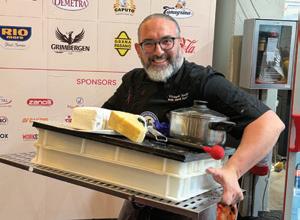
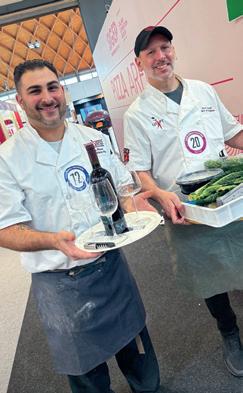


Eight members of the U.S. Pizza Team traveled to Rimini, Italy, to compete in the 2025 Pizza Senza Frontiere competition, representing USA pizza with honor—and a little flair.
With the entire competing squad placing respectably in each of their events, ranging from Pizza Classica to Pizza and Wine, special accolades went to superstar McKenna Carney for taking 2nd place in Freestyle Acrobatics and to duo Rico Lunardi and Mike Pitera for taking 4th place in the Pizza and Wine category.
U.S. PIZZA TEAM WORLD RANKINGS:
2nd Place, Freestyle Acrobatics: McKenna Carney, The Nona Slice House, Safety Harbor, FL
4th Place, Pizza e Vino: Rico Lunardi, Slice On Broadway, Pittsburgh, PA, and Mike Pitera, Pizza a Modo Mio, Charleston, SC
7th Place, Pizza e Cocktail: Sean Dempsey, Danger Von Dempsey’s, Aberdeen, SD
7th Place, Pizza in Teglia: Vitangelo Recchia, Bella Napoli Pizzeria & Restaurant, Port Charlotte, FL
8th Place, Pizza in Teglia: Jamie Culliton, The Nona Slice House
Additional members representing the USPT were George Taylor, Taylors’ Pizza House, Endwell, NY; David Solum, Danger Von Dempsey’s; and Travis Siebens, The Nona Slice House.













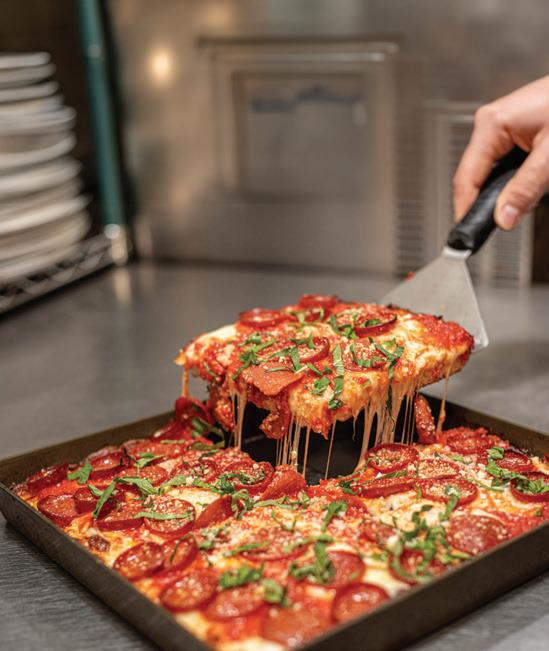

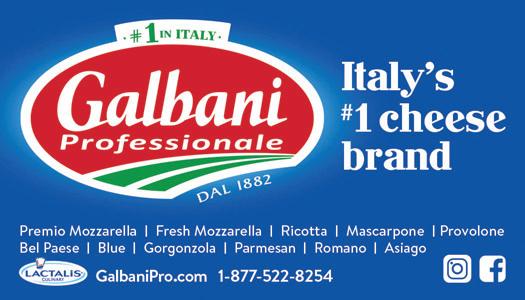





















































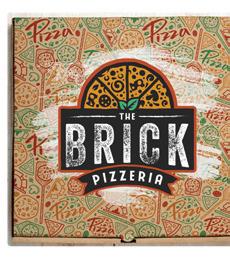













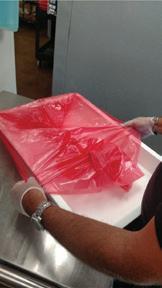

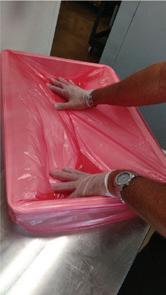









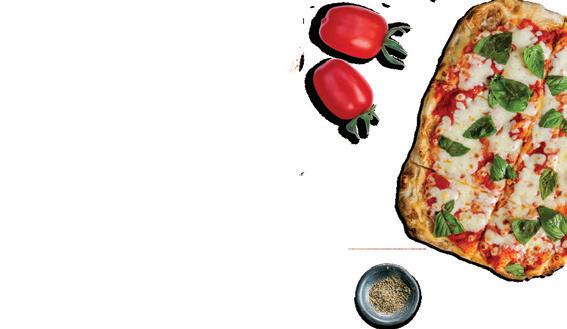







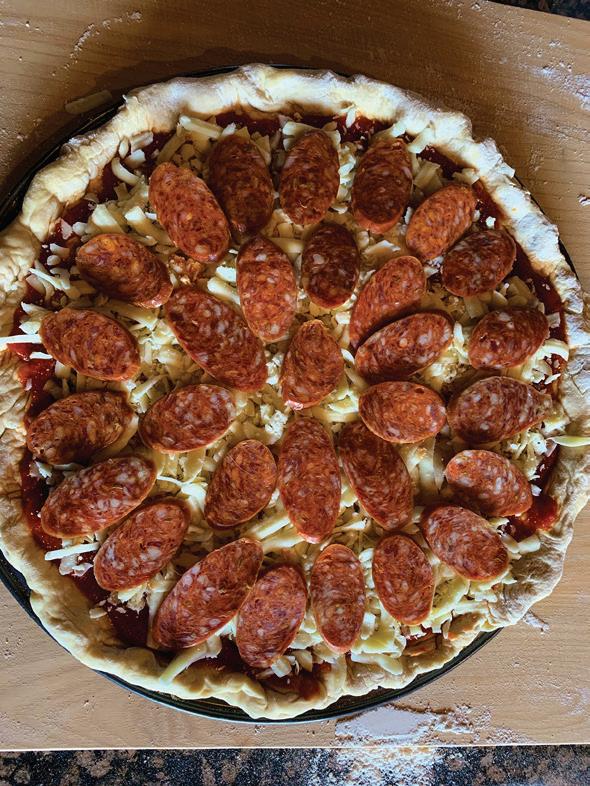








(Clockwise from left) Frank Pepe opened his first location, now called The Spot, in 1925; Frank Pepe Pizzeria Napoletana is known for its coal-fired apizza; the original crew works at The Spot; Filomena and Frank pose at their original pizzeria; the business expanded to its current New Haven outpost in 1937.

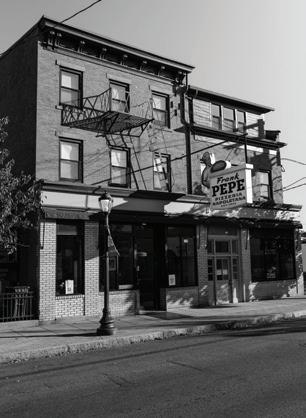
Jennifer Bimonte-Kelly, co-owner of Frank Pepe Pizzeria Napoletana, calls her grandfather Frank Pepe “the quintessential American immigrant.” After arriving in the U.S. from Italy as a teenager in 1909, then fighting overseas in World War I, Frank found work at a bakery in New Haven, Connecticut. There, he started making “apizza,” the style he knew in his hometown of Maiori.
“Frank Pepe began selling his ‘tomato pies’ off a special headdress, walking through the Wooster Square market with several pies perched atop his head,” Bimonte-Kelly says. “Pepe’s continued success selling pizzas in the area convinced him and his wife to open their own restaurant.” Frank and Filomena opened their doors on Wooster Street in 1925—marking this year as the iconic pizzeria’s centennial anniversary.
Frank Pepe, inducted into PMQ’s Pizza Hall of Fame in 2010, started out by selling just two types of apizza. One featured tomatoes, grated Pecorino cheese, garlic, oregano and olive oil; the second added anchovy. “Because refrigeration was limited in the 1920s, Pepe’s did not initially offer mozzarella cheese on their pizza,” Bimonte-Kelly explains. “The Original Tomato Pie is still offered today, and anchovy continues to be available as an added topping. Later additions to the menu include
BY TRACY MORIN
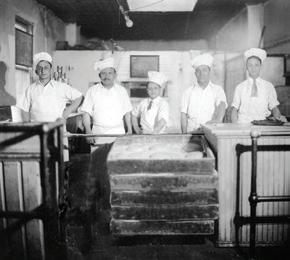
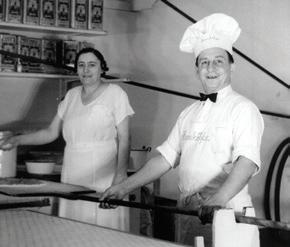
the signature White Clam Pie, which was created by Frank Pepe in the 1960s and remains one of the restaurant’s most popular menu items today.”
In 1937, Pepe moved his primary business next door, to a larger Wooster Street storefront, where it remains today. (The original, known as “The Spot,” handles private parties.) The pizzeria’s second outpost didn’t arrive until 2006—in Fairfield, Connecticut—but now 17 locations dot the East Coast, stretching down to South Florida.
“We’ve proudly upheld the legacy my grandfather started, which is rooted in tradition, family and a commitment to our loyal guests, whom we consider family,” Bimonte-Kelly says. “Our success comes from the foundation my grandfather built 100 years ago. He believed in doing one thing really well—making pizza—and that’s the heart of what we still do today….just perfect pizza with the char from our coal-fired oven, high-quality ingredients and the same recipe we’ve used for 100 years. That’s what makes Pepe’s special. It’s not about doing everything—it’s about doing one thing really well.”
Read the full Q&A celebrating Frank Pepe’s 100 years at PMQ.com




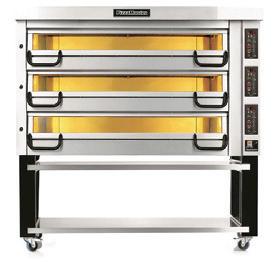



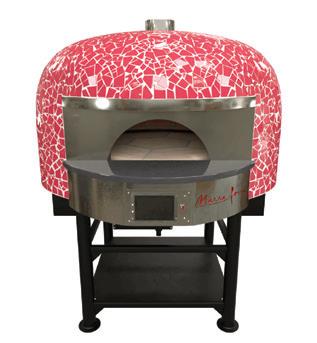

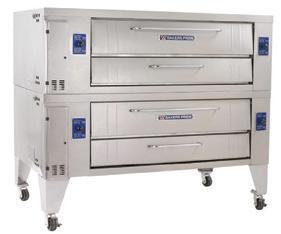

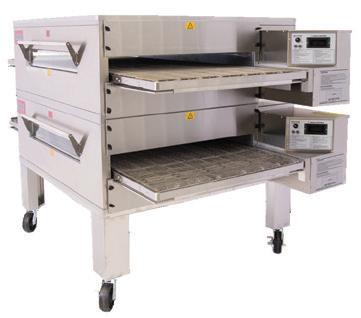






























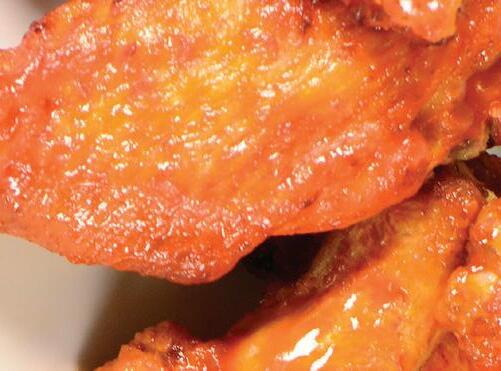

















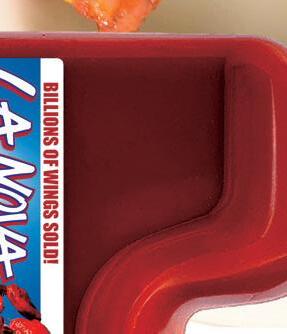



























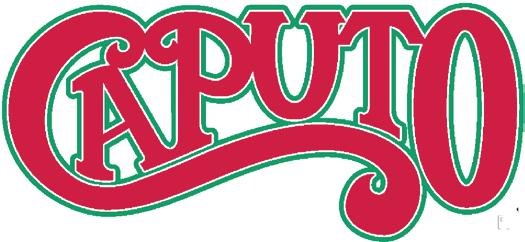
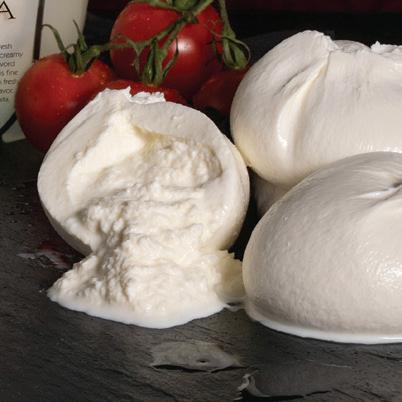
Our individually packaged burrata is crafted for your convenience. Each single portion is sealed for freshness, ensuring an extended shelf life. Savor the creamy richness of burrata at your own pace, minimizing waste without compromising quality.

Please join us at the International Pizza Expo March 25-27 at booth # 1119
